How to structure your viva presentation (with examples)
Most PhD vivas and PhD defences start with a short presentation by the candidate. The structure of these presentations is very important! There are several factors and approaches to consider when developing your viva presentation structure.

Factors to consider when developing a viva presentation structure
Structuring your viva presentation traditionally, structuring your viva presentation around key findings, structuring your viva presentation around key arguments, structuring your viva presentation around case studies, final thoughts on viva presentation structures.
A PhD viva or PhD defence is often one of the last steps that PhD students have to pass before receiving a doctorate. The viva or defence usually starts with a short presentation of the PhD candidate on the PhD thesis.
Presenting a whole PhD in a short amount of time is very challenging. After all, a PhD is often the result of several years of work!
It is simply impossible to include everything in a viva presentation.
Therefore, tough choices have to be made in terms of what to include, what to highlight, and what to exclude.
The structure of a viva presentation plays a crucial role in bringing across the key messages of your PhD.
Therefore, there are several factors to consider when developing a viva presentation structure:
- Available presentation time : Viva presentations usually last between 10 and 20 minutes, but every university has different regulations. Developing a structure for a viva presentation that lasts 10 minutes is different from developing one for a presentation that lasts 20 minutes or more. Thus, find out how much time you are allowed to present!
- The key contribution of your thesis: The structure of a viva presentation should reflect the content and key messages of the PhD thesis. For instance, if you have written a very theoretical PhD thesis, it makes no sense to structure your whole presentation around your data collection and analysis. Make sure that the viva presentation structure is in line with your main messages.
- University standards: It is recommended to discuss your ideas and plans for your viva presentation structure with others, as each university may have may be different (and even unspoken) rules and standards. Ask your supervisors about their preferred viva presentation structure. And talk to your peers who defend their theses before you.
- Clear storyline : Every presentation should have a logical structure which allows the audience to follow a crystal-clear storyline. This is also true for viva presentations. Thus, clarify your storyline and develop a presentation structure that supports it.
A very traditional viva presentation structure simply follows the structure of the PhD thesis.
This means that the viva presentation covers all parts of the thesis, including an introduction, the literature review, the methodology, results, conclusions, etcetera.
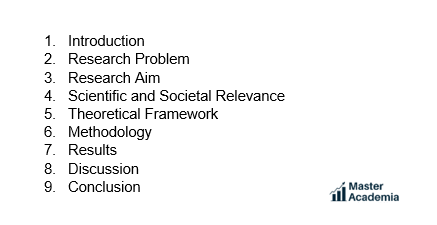
The advantage of this rather traditional format is that it provides information on each thesis chapter. Furthermore, it is relatively easy to prepare.
The disadvantage of this traditional format is that it is very challenging to fit all the information in a – let’s say – 10-minute presentation.
Furthermore, it can result in a presentation that is quite boring for the examiners, who have read the thesis in preparation for the viva.
One interesting way is to structure a viva presentation around the key findings of the PhD research.
For instance, you can select your three main findings which you each connect to the existing literature, your unique research approach and your (new) empirical insights.

A viva presentation structure around key findings emphasises the unique contribution of a PhD thesis, particularly in empirical terms.
A challenge of this structure, however, is to narrow down the presentation to a handful of key findings.
Furthermore, it might be tricky to find enough time during the presentation to discuss your theoretical framework and embed your discussion in the existing literature when addressing complex issues.
A viva presentation structured around key arguments is very similar to one that is structured around key findings. However, while key findings place more emphasis on the empirical data, key arguments operate at a higher level:
Arguments are sets of reasons supporting an idea, which – in academia – often integrate theoretical and empirical insights.
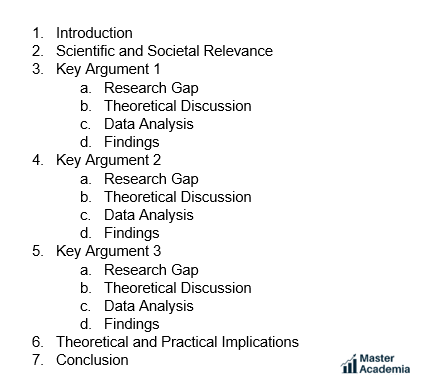
So, for example, your key argument 1 is your stance on an issue, combining your theoretical and empirical understanding of it. You use the existing theory to understand your empirical data, and your empirical data analysis to develop your theoretical understanding.
A viva presentation structure around key arguments is probably the most difficult viva presentation structure to choose.
However, if it is well done, it is probably the most academically strong and advanced way of defending your PhD.
Another common way to structure a viva presentation is around case studies or study contexts.
This structure is only applicable when the PhD thesis includes a comparative (case study) analysis, which is quite common in the social sciences and humanities.
A presentation can, for instance, first discuss the theoretical framework and research approach, then present Case 1, and then Case 2 or more if applicable.
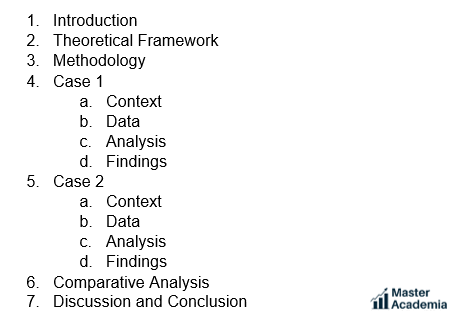
A viva presentation structure around case studies can be easy to follow for the audience, and shed light on the similarities and differences of cases.
However, as always, you need to reflect on whether the structure supports your key message. If your key message does not centre around similarities and/or differences in cases, this is not the structure for you!
Every PhD thesis is unique, and therefore also every viva presentation structure should be unique.
The key to a good viva presentation is to choose a structure which reflects the key points of your PhD thesis that you want to convey to the examiners.
The example viva presentation structures discussed here intend to showcase variety and possibilities and to provide inspiration.
Never just copy a viva presentation structure that worked for others .
Always think about what fits best to your thesis, asking yourself the following questions:
- What is the main message of my PhD that I want to share during my viva?
- How do I develop a crystal clear storyline to bring this main message across?
- How can I structure my viva presentation to support and facilitate this storyline?
Master Academia
Get new content delivered directly to your inbox.
Subscribe and receive Master Academia's quarterly newsletter.
18 common audience questions at academic conferences (+ how to react)
10 reasons to do a master's degree right after graduation, related articles.

Dealing with failure as a PhD student

13 awesome academic phrases to write your methodology (+ real examples)

Major revisions: Sample peer review comments and examples

How to write a convincing research statement
- Slidesgo School
- Presentation Tips
How to Start a Thesis Defense Presentation

After months and years of hard work, the moment to wrap things all up is finally here—your thesis defense presentation.
Whether you’re pursuing a master’s degree or doctorate, it’s the final step to that much-deserved achievement.
A thesis defense requires a lot of prior research and preparation. And as important as its content is, so is how you present it because a stunning design with clear data and text hierarchy plays an immense role in comprehension.
In this article, we’ll explore how you make your thesis defense .
The organization is the key to success. Establishing some previous steps before any project or work is essential for the result to be very positive. And the defense of a thesis could not be less.
Below, we will develop all the necessary steps to make a thesis defense presentation and we will give you some tips on how to carry them out.
How to Make an Amazing Presentation
Defining the concept of your thesis presentation, structuring your thesis defense presentation, how do you welcome the audience, tell them why you did this thesis, go into the content by explaining your thesis part by part, how to end the defense of the thesis.
After a long time of research and study, the content of your thesis is ready. Now, you have to find the best way to reflect all that effort behind your work. The information comes across more clearly if you use a visual format, as it attracts the attention of the audience. To present your thesis information in a clear, concise, and ultimately amazing way, you can use one of our unique thesis defense templates , available at Slidesgo.
As an example, in this article, we are going to use the Ecology Thesis template . With it, we will show you what to include in your presentation and how to make an attractive design.
After choosing the Google Slides and PowerPoint template that best suits the needs and subject matter of your thesis, it is time to define an overarching concept.
This is the main theme on which your designs are based. It must be relevant to your thesis as its purpose is to guide your selection of colors, typography, images, style, etc.
These must be portrayed in a way that supports the main message of your slides and should be aligned with your concept both visually and sociologically.
Once you have defined the concept, you will have to move on to the next step: structuring the content of your thesis. A good structure will show that there is a good organization behind the work, but most importantly: it will highlight your content.
In this article, we are going to show you a structure that could be a good example of how to structure a thesis, but you can adapt it to what your specific content requires.
Before you begin your thesis defense, you should welcome your audience. A good presentation will make you connect with your audience, which will result in more general interest in your work.
Use an appropriate language register (avoid informal language), but be approachable and natural.
"Welcome to the thesis defense on [the title of your thesis]". Next, introduce yourself with your name and give a short description of your background and occupation.
Don't forget to say “thank you for attending!”
To continue establishing that connection with your audience, explain the reasons that led you to do this thesis. Tell the professional reasons, and you can even say some personal ones, which will denote closeness, and your audience will appreciate it.
Now it's time to go into the content of the thesis ! After these preliminary steps, which are just as important as the thesis itself, it is time to explain part by part the structure (which you had previously established). We are going to propose a structure for your project, but the final decision is always yours!

First impressions are very important. Because your title page is the very first thing viewers see, it must be striking and impactful. It also sets the stage for the rest of your slides.
In one glance, the following should be established:
- Thesis defense topic
- Design style
For instance, the ecology thesis’s title page uses illustrations of a natural landscape to represent the topic of nature and a striking shade of blue to set the tone.
The sans serif font used depicts clean-cut typography and style and the thesis topic is written in large and bold typography, which draws attention to it immediately.
.jpg)
Right after your title page, include an introduction slide to provide more details about your topic.
This means explaining what you hope to answer with your research, its importance to your field, and why you chose it.
Continue to incorporate design elements relevant to your concept. This example has done just that by using a different natural landscape and including animals. For coherence, stick to the same typography and style throughout your presentation.
.jpg)
The aim of the literature review slide is to illustrate your knowledge of your thesis topic and any relevant theories.
Walls of text kill a design. For clarity, we recommend presenting this with bullet points. Each one should be short and sweet and only touch on the basics; you can elaborate on them in your speech.
Don’t forget to be consistent with your design. In our example, we’ve maintained the tone of blue chosen and added illustrations of leaves in the far corners of the slide.
Also, address similar research that has been done. This is to showcase your topic’s originality and, if relevant, how it’s different and/or an improvement from previously done research.
.jpg)
This is one of the most important parts of a thesis defense presentation.
It allows your viewers to assess the rationality and validity of your approach and consequently, the accuracy of your results.
A great methodology slide explains the what , how, and why :
- What method did you use for your research
- Why did you choose it
- How did you conduct it
Because this part of your thesis will be rather technical, the most effective way to aid understanding is by using graphics like charts and tables.
.jpg)
Keep text to a minimum to avoid drawing attention away from the graphics. If there is a text that must absolutely be included, consider using bullet points and keep them short.
Don’t forget to maintain color, style, and typography coherence.
.jpg)
The results slides are easily the most quantitative part of a thesis defense.
Here, your aim is to simply introduce your findings. Select the most impactful data and highlight them here.
Just as with methodology, use graphics like charts, tables, and graphs to portray the data in a clear way. And, once again, try not to write too much text. Let the visual content do the talking .
.jpg)
After you’ve introduced your data, the next step would be to help your audience make sense of it. That means understanding what it means in the context of your thesis research topic and your discipline.
Simply put, you should answer the question: What do the numbers mean?
The best way to approach this would be to do it as if you were creating an infographic .
Illustrations like icons are a quick and simple way to represent your message. It also reduces the amount of text on your slide, which makes the information much more digestible.
For a balanced thesis presentation, you should also address any outliers and anomalies.
To quote bestselling author Robin Sharma, “Starting strong is good. Finishing strong is epic.”
That’s exactly what to aim for in your conclusion.
Provide an overview of your thesis topic and remind your audience what you set out to answer with your research. In our example, we’ve used three icons accompanied by a short title and text.
.jpg)
Following that, reiterate the important points of your research results you want your audience to take away from your thesis defense presentation.
You can do so by expanding the next slide to have more icons and points, for example.
.jpg)
Don’t forget to address any shortcomings and limitations in your approach and extra points for suggesting possible improvements for future research.
We are going to give you a little tip to make your thesis defense a success. You can combine your defense with good public speaking techniques. Take a look at our article "How to become a great speaker" .
We hope this article has been of great help, have you already seen our templates to make the presentation of your thesis ? Choose the one that best suits your needs, we are sure that one of them will go perfectly with your thesis presentation!
Good luck from Slidesgo.

Do you find this article useful?
Related tutorials.

Entrepreneurship and Personal Development Hackathon: The magic of learning by doing
The new generations show us that the way of learning has completely changed. Now more than ever, it is key to encourage and support the development of social and entrepreneurial skills in children so that they can become more actively involved in their learning. Participating in creative projects and collaborative activities allows them to explore and learn on their own about topics that interest them, solve their problems with more autonomy, and work better in teams.This idea was the motivation behind the Junior Entrepreneurship and Personal Development Hackathon organized by Slidesgo in collaboration with Genyus School. At this event, more than 150 children had...

Work faster, teach better: boost your skills with Slidesgo Academy
We truly believe that every educator has what it takes to be a fantastic presenter, but we’re also aware of the time it takes to hone these skills. Enter Slidesgo with a great, fast solution: Slidesgo Academy.At this empowering and encouraging platform, we’ve partnered with veteran classroom educators to compile the best tips that will enable you to create engaging, eye-catching, and top-quality presentations for your students and fellow educators. You’ll surprise yourself with how quickly you can craft lessons that engage and excite. Join us as a student, and become the best teacher you can be!

7 tips to create a positive classroom culture
No matter if it's been ages since you last stepped into a classroom or just a long time ago―there’s probably a particular learning experience you often find yourself thinking about. Maybe it was a passionate teacher who kept the whole class engaged, or perhaps a classmate who lent you a hand with a tricky topic. Positive classroom experiences do leave a lasting mark on us, so it makes perfect sense that people leading a classroom aim to create the finest possible learning setting. In this article, we’ll share some tips to help you turn a regular classroom into a positive space.

How to create a word cloud in Google Slides
There are many ways to improve your Google Slides presentation. From choosing the right font to finding the right template, good presentations keep an audience engaged and convey a message in a clear way.Knowing how to visualize data in a slideshow is one of those actions that have a huge impact on the success of a presentation. At the end of the day, plain data fails to motivate decisions as effectively as clear insights do. This is when powerful visual tools like word clouds step in. Let us tell you all about them.

Princeton Correspondents on Undergraduate Research
How to Make a Successful Research Presentation
Turning a research paper into a visual presentation is difficult; there are pitfalls, and navigating the path to a brief, informative presentation takes time and practice. As a TA for GEO/WRI 201: Methods in Data Analysis & Scientific Writing this past fall, I saw how this process works from an instructor’s standpoint. I’ve presented my own research before, but helping others present theirs taught me a bit more about the process. Here are some tips I learned that may help you with your next research presentation:
More is more
In general, your presentation will always benefit from more practice, more feedback, and more revision. By practicing in front of friends, you can get comfortable with presenting your work while receiving feedback. It is hard to know how to revise your presentation if you never practice. If you are presenting to a general audience, getting feedback from someone outside of your discipline is crucial. Terms and ideas that seem intuitive to you may be completely foreign to someone else, and your well-crafted presentation could fall flat.
Less is more
Limit the scope of your presentation, the number of slides, and the text on each slide. In my experience, text works well for organizing slides, orienting the audience to key terms, and annotating important figures–not for explaining complex ideas. Having fewer slides is usually better as well. In general, about one slide per minute of presentation is an appropriate budget. Too many slides is usually a sign that your topic is too broad.

Limit the scope of your presentation
Don’t present your paper. Presentations are usually around 10 min long. You will not have time to explain all of the research you did in a semester (or a year!) in such a short span of time. Instead, focus on the highlight(s). Identify a single compelling research question which your work addressed, and craft a succinct but complete narrative around it.
You will not have time to explain all of the research you did. Instead, focus on the highlights. Identify a single compelling research question which your work addressed, and craft a succinct but complete narrative around it.
Craft a compelling research narrative
After identifying the focused research question, walk your audience through your research as if it were a story. Presentations with strong narrative arcs are clear, captivating, and compelling.
- Introduction (exposition — rising action)
Orient the audience and draw them in by demonstrating the relevance and importance of your research story with strong global motive. Provide them with the necessary vocabulary and background knowledge to understand the plot of your story. Introduce the key studies (characters) relevant in your story and build tension and conflict with scholarly and data motive. By the end of your introduction, your audience should clearly understand your research question and be dying to know how you resolve the tension built through motive.

- Methods (rising action)
The methods section should transition smoothly and logically from the introduction. Beware of presenting your methods in a boring, arc-killing, ‘this is what I did.’ Focus on the details that set your story apart from the stories other people have already told. Keep the audience interested by clearly motivating your decisions based on your original research question or the tension built in your introduction.
- Results (climax)
Less is usually more here. Only present results which are clearly related to the focused research question you are presenting. Make sure you explain the results clearly so that your audience understands what your research found. This is the peak of tension in your narrative arc, so don’t undercut it by quickly clicking through to your discussion.
- Discussion (falling action)
By now your audience should be dying for a satisfying resolution. Here is where you contextualize your results and begin resolving the tension between past research. Be thorough. If you have too many conflicts left unresolved, or you don’t have enough time to present all of the resolutions, you probably need to further narrow the scope of your presentation.
- Conclusion (denouement)
Return back to your initial research question and motive, resolving any final conflicts and tying up loose ends. Leave the audience with a clear resolution of your focus research question, and use unresolved tension to set up potential sequels (i.e. further research).
Use your medium to enhance the narrative
Visual presentations should be dominated by clear, intentional graphics. Subtle animation in key moments (usually during the results or discussion) can add drama to the narrative arc and make conflict resolutions more satisfying. You are narrating a story written in images, videos, cartoons, and graphs. While your paper is mostly text, with graphics to highlight crucial points, your slides should be the opposite. Adapting to the new medium may require you to create or acquire far more graphics than you included in your paper, but it is necessary to create an engaging presentation.
The most important thing you can do for your presentation is to practice and revise. Bother your friends, your roommates, TAs–anybody who will sit down and listen to your work. Beyond that, think about presentations you have found compelling and try to incorporate some of those elements into your own. Remember you want your work to be comprehensible; you aren’t creating experts in 10 minutes. Above all, try to stay passionate about what you did and why. You put the time in, so show your audience that it’s worth it.
For more insight into research presentations, check out these past PCUR posts written by Emma and Ellie .
— Alec Getraer, Natural Sciences Correspondent
Share this:
- Share on Tumblr


- How to Give a Presentation as A PhD Student
- Doing a PhD
At some point in their career, most researchers will be asked to give a presentation at a conference. These podium talks can be a brilliant way to promote yourself as an academic and also to disseminate your work to a wider audience. Standing up and giving a talk to a large audience can feel scary, particularly if you feel under-prepared. However, with enough preparation and practice this could become an enjoyable experience and maybe even one you look forward to!
Here are a few tips from us to help you with preparation for your next (or first) presentation.
Keep It Simple
Typically, any talk you give will be accompanied by a series of slides. The key thing to remember here is ‘less is more’. Keep the message on each slide very clear with minimal text and ideally an image on every slide. Remember that these slides are designed to support what you’re talking about rather than being a script to read from.
Have a Structure
Prepare your slides with a logical structure in mind. If you’re presenting an experimental study, this may be as simple as: Introduction, Methods, Results, Discussion and Conclusion. Think about what one thing you want the audience to take away from your talk – what’s the take-home message? A common mantra that’s used by many researchers is to (1) tell the audience what you’re going to tell them, (2) tell them and (3) tell them what you’ve told them. Simple!
Practice, Practice, Practice
There’s really no better substitute for building confidence in giving your talk than by practising it as much as you can. That’s not to say that you should learn it word for word and simply repeat from memory, but it should feel very natural by the time you come to present. A great idea is to write out a script of what you’d like to say and then amend it as you read it out aloud – you’ll find the way you structure your sentences or the words you use may differ slightly as you present out loud versus just writing down in text form.
Practice by yourself as you’re developing your thoughts and the flow of your talk but make sure you also practice in front of others, such as those in your lab, your supervisor and your friends and family.
It’s All in The Delivery
You know what you’re going to say, make sure you also practice how you’re going to say it. Make a conscious effort to speak a little (emphasis on the little!) slower than you normally would. Don’t forget to breathe and be happy – this is a chance to show off the great work that you’ve been doing. Speak clearly and not too quietly and try to connect with your audience – think of this as a discussion you’re having with them about your research. If you can, try to arrive at the presentation hall before others arrive so you have an opportunity to stand at the podium and visualise yourself giving your talk – this way when you go up to present, the environment will be a little more familiar to you. Enjoy it!
Browse PhDs Now
Join thousands of students.
Join thousands of other students and stay up to date with the latest PhD programmes, funding opportunities and advice.
The Ultimate Guide to Preparing Your PhD Dissertation Defense Presentation
January 12, 2023

Chances are, you’ve been waiting years for this moment: preparing your PhD dissertation defense.
You’ve made it this far in your doctorate journey, so you’ll really want to nail the final thing standing between you and your PhD.
We’ll break down everything you need to know, from what the dissertation defense is to how to prepare and more importantly, succeed.
Here’s our ultimate guide for preparing for your PhD dissertation defense.
What Is a PhD Dissertation Defense Presentation?
A PhD dissertation defense is your chance to defend your work in front of the academics analyzing your research. You might also hear this called a “thesis defense.”
Although the thought of having experts critique you in a cross-examination setting, a dissertation defense is just an opportunity for you to show off your best work .
What Is a PhD Dissertation Committee?
A PhD dissertation committee is a group you assemble to guide you through the dissertation process, from preparation to the revision of your dissertation.
You choose the members of the committee after all the academic work is finalized. Usually, members will be trusted faculty — people you know well who you might consider a mentor.
How to Prepare for Your PhD Dissertation Defense Presentation
Preparing for your PhD dissertation defense doesn’t have to be stressful.
Try using Yoodli , an AI-powered speech coach that analyzes your speaking patterns and identifies areas in which you can improve. By practicing your dissertation defense presentation through Yoodli, you’ll be able to not only improve your speaking, but boost your confidence as well.
For example, you can take an in-depth look at the filler words you use, including which ones come up the most often and precisely how often they come up.

Here are three more tips for preparing your PhD dissertation defense.
1. Don’t wait around.
One of the best things you can do for yourself when preparing your PhD dissertation defense is to start the work early. You won’t regret starting “too early” like you would regret starting the preparation too late in the game.
Designing your presentation slides will take time and isn’t something you can slap together in a pinch. Right after your thesis is finalized, start on the slides. Your aim is to impress the committee with a thought-out, clear presentation that presents your work in a good light.
2. Practice, practice, practice.
It doesn’t matter how confident or comfortable you are with regard to your work and the actual PhD dissertation defense — you need to practice like your life depends on it.
Be sure to practice not only the presentation, but also your body language, like hand gestures . You don’t want to seem too stiff or anxious during your dissertation defense, and practicing all these elements at once gives you an idea of what you need to work on.
You’ll also want to work on your tone, to make sure you don’t come off as sounding monotonic . You want the committee members to feel interested and engaged.
Taking one of Yoodli’s free public speaking courses — such as the fundamentals of public speaking — can also build on your confidence and make you feel more comfortable during the dissertation defense.
Check out Yoodli’s 10-minute course here:
3. Check out other candidates’ presentations.
Sometimes, universities will offer open PhD dissertation defense presentations. If your university is one of them, it’s a great idea to attend a few . If your university doesn’t offer open dissertation presentations, check out other local universities that might offer these.
Watching other candidates’ presentations can help you not only get a firsthand look at how a presentation should (or shouldn’t!) go, but also to affirm that dissertation defense presentations aren’t as awful and scary as you might think they are. You might even get some insight or a few ideas for your own presentation while you’re at it.
The Bottom Line
Preparing for your PhD dissertation defense presentation doesn’t have to be overwhelming. After all, it’s all part of your doctorate journey . With preparation and practice, you can use this opportunity to shine and show off your best work.
Start practicing with Yoodli.
Getting better at speaking is getting easier. Record or upload a speech and let our AI Speech Coach analyze your speaking and give you feedback.

PhD Dissertation Defense Slides Design: Example slides
- Tips for designing the slides
- Presentation checklist
- Example slides
- Additional Resources
Acknowledgments
Thank all ph.d.s for sharing their presentations. if you are interested in sharing your slides, please contact julie chen ([email protected])., civil and environmental engineering.
- Carl Malings (2017)
- Irem Velibeyoglu (2018)
- Chelsea Kolb (2018)
- I. Daniel Posen (2016)
- Kerim Dickson (2018)
- Lauren M. Cook (2018)
- Xiaoju Chen (2017)
- Wei Ma (2019)
- Miranda Gorman (2019)
- Tim Bartholomew (2019)
- << Previous: Presentation checklist
- Next: Additional Resources >>
- Last Updated: Jan 9, 2024 11:18 AM
- URL: https://guides.library.cmu.edu/c.php?g=883178
PhD Defense Template
You’ve done the hard work to prepare your PhD dissertation, and now there’s only one step left: your defense. And Beautiful.ai has the perfect presentation template to help you along the way.
These customizable template slides have all the basic elements of a PhD defense presentation, including an abstract, methodology, research findings, executive summary, and more. The result? A streamlined presentation that’s as professional as it is impressive. All with just a few clicks of the mouse.
Our PhD defense template can also help you:
- Customize your PhD presentation for different audiences
- Synthesize months of academic work into a concise presentation
- Successfully defend your PhD thesis to your panel
Use our template to create an effective PhD defense presentation
Your PhD defense presentation is a critical step in your academic journey – one that requires a smart and sophisticated format, layout, and story flow. That’s why our template includes everything you need to create an effective presentation. Tailoring this defense template to your unique PhD thesis is simple. Whether you need to create additional data points or showcase more findings, you can quickly bring your visions to life with these customizable templates and our entire library of professionally designed template slides.

Pro Tips for creating your own PhD defense presentation template
When you are thinking of creating your own impactful Phd defense presentation, keep these best practices in mind:
Condensing hours and hours of research can be daunting. Build an outline or table of contents first, then simply stick to that structure as you create your presentation.
It can be easy to get caught up in your research and findings, but don’t forget to answer critical questions like, ‘Why is this important?’ and ‘What results have you achieved?’
Remember: You aren’t recreating your entire thesis into a visual presentation. Limit the amount of content and data you add to each slide.
Your PhD defense presentation is your chance to share all of your hard work. Don’t be afraid to showcase bits of your personality throughout.
More Popular Templates

SEO Report Template
Use an SEO report template to update your clients, managers, and stakeholders on the performance of SEO campaigns.

Customer Profile Presentation Template
Pinpoint the best marketing segments for your brand and qualify leads with our streamlined customer profile template.

Snapchat Pitch Deck
This Snapchat pitch deck shows how simple presentations can persuade investors into action with simple, clean design.

Peloton Pitch Deck
This Peloton pitch deck shows how simple presentations can persuade investors into action with simple, clean design.

Business Proposal Presentation Template
A persuasive business proposal starts with a presentation template. Pitch investors and secure projects with this smart business proposal presentation that adapts to your brand.

Dropbox Pitch Deck
You’ve likely used DropBox for saving and sharing files, but 13 years ago MIT students Drew Houston and Arash Ferdowsi were just hoping for a little funding to get their start-up off the ground. The initial pitch deck landed them their $1.2M seed round in 2007, though it left room for improvement. We recreated it in Beautiful.ai.
Home Blog Presentation Ideas How To Do a Proper Thesis Defense Using the Right PowerPoint Presentation
How To Do a Proper Thesis Defense Using the Right PowerPoint Presentation
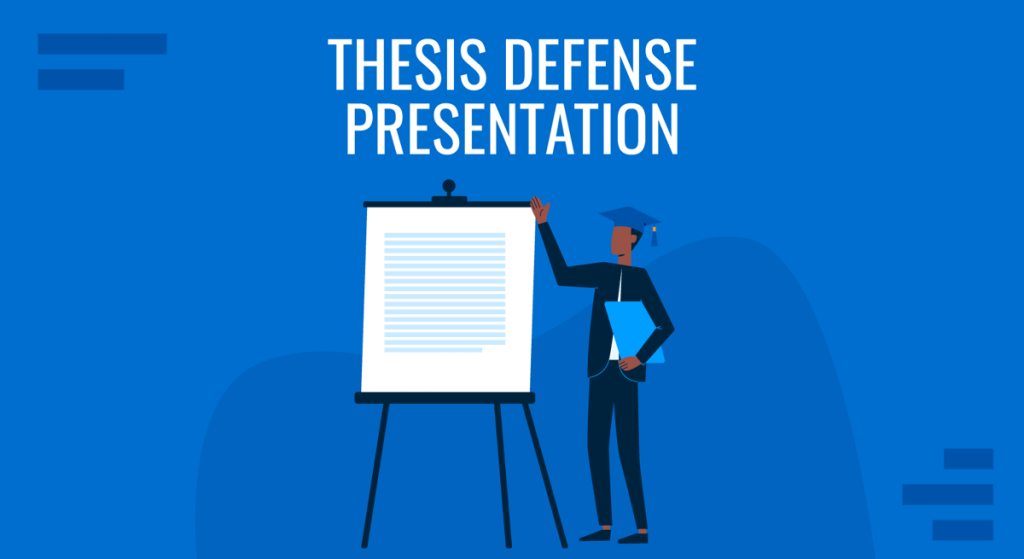
Writing a thesis is stressful, but preparing an oral defense can be even more painful. But it doesn’t have to be; with proper preparation and a good presentation, you will be able to better equip yourself comes time to present your thesis defense.
But what makes a good thesis defense?
A proper presentation helps you with your thesis defense because it helps you capture the panels’ attention and gives you cues and reminders on what to say as well.
It also helps keep your data organized while visually looking good and provides a flow structure for the rest of your presentation.
In today’s article, we will be giving you The Right PowerPoint Templates for Your Thesis Defense and a powerful outline composed of best practices and layouts specifically designed to help you defend your thesis in both written and oral presentations.
In the next segments of this article, we’ll walk you through the most feasible process on how to ace this kind of presentation.
Let’s dive into the outline of what makes a great thesis defense.
Thesis Defense Overview
Similarities.
- Type of Degree
Thesis and Dissertation Distinction Varies on Location
Three most common thesis defense myths, how to use chatgpt to structure your thesis.
- Introduction
- Literature Review
- Methodology
- Acknowledgements
- Questions and Answers
- Contact Information
- Tips During Your Oral Defense
- More Quick Tips on How to Present
A thesis defense is composed of two parts – a thesis and a defense.
The thesis, according to Grad School Hub , represents a student’s collective understanding of his or her program and major.
Universities often include a thesis in every course as one of the final requirements to earn a particular graduate or postgraduate degree.
The thesis, however, isn’t just a mere requirement.
It helps the students to grow out of their shell from their respective discipline and give them the opportunity to present all the findings of their study.
Moreover, some people think a thesis is just a long essay, but it’s not. Unlike an essay, a thesis needs to assert something.
This can be considered one of the most crucial research documents that a student makes during their academic schooling .
On the other hand, defense is the presentation of the pieces of evidence to support and prove your research.
It’s the most essential part of the thesis process.
Your presentation has to be prepared to answer questions from members of the committee and any other panel present, and it’s your job to convince them and defend your thesis with ample proof.
Prior to presenting, you have to carefully determine what appropriate evidence should be presented before the panel, depending on what thesis you have to defend.

Thesis and Dissertation Distinguished
A thesis or dissertation is usually required to complete a particular graduate degree. These two words are often used interchangeably by most students when referring to research studies.
But while being almost similar in format or structure, it’s worth noting that they have significant differences that set them apart from each other.
The very reason why thesis and dissertation are treated the same is that these two are both extensive papers. Not just merely long essays like what others are claiming.
Both of these papers are extensive. This is why students are given ample time, usually the entire last semester of the last year of study, to complete all the requirements and finally acquire their degree.
With regards to structure, both papers are very similar with few differences.
Differences Between Thesis and Dissertation
One of the significant differences between the two is to whom the paper is assigned. A thesis is usually required for those students earning a bachelor’s or master’s degree. While a dissertation is for those, who want to obtain a doctorate degree.
However, not all students taking a master’s degree are required to make a thesis. Prior to their enrollment, they have been given a choice of whether they’ll go for a non-thesis program or with a thesis.
Those who have a plan to escalate their degree to a doctorate eventually should take the path of a thesis. This is to prepare themselves for a more extensive dissertation requirement as doctorate students. Otherwise, they will be only limited to earning a master’s degree.

But above all, the most significant difference between the two papers is the purpose for which it is written.
A thesis, like what has been mentioned above, is being done by students obtaining a bachelor’s or master’s degree and has the purpose of testing their understanding of the discipline they’re engaged with.
A thesis is focused on obtaining technical expertise.
On the other hand, a dissertation is made for students to come up with an original study that other researchers haven’t already studied.
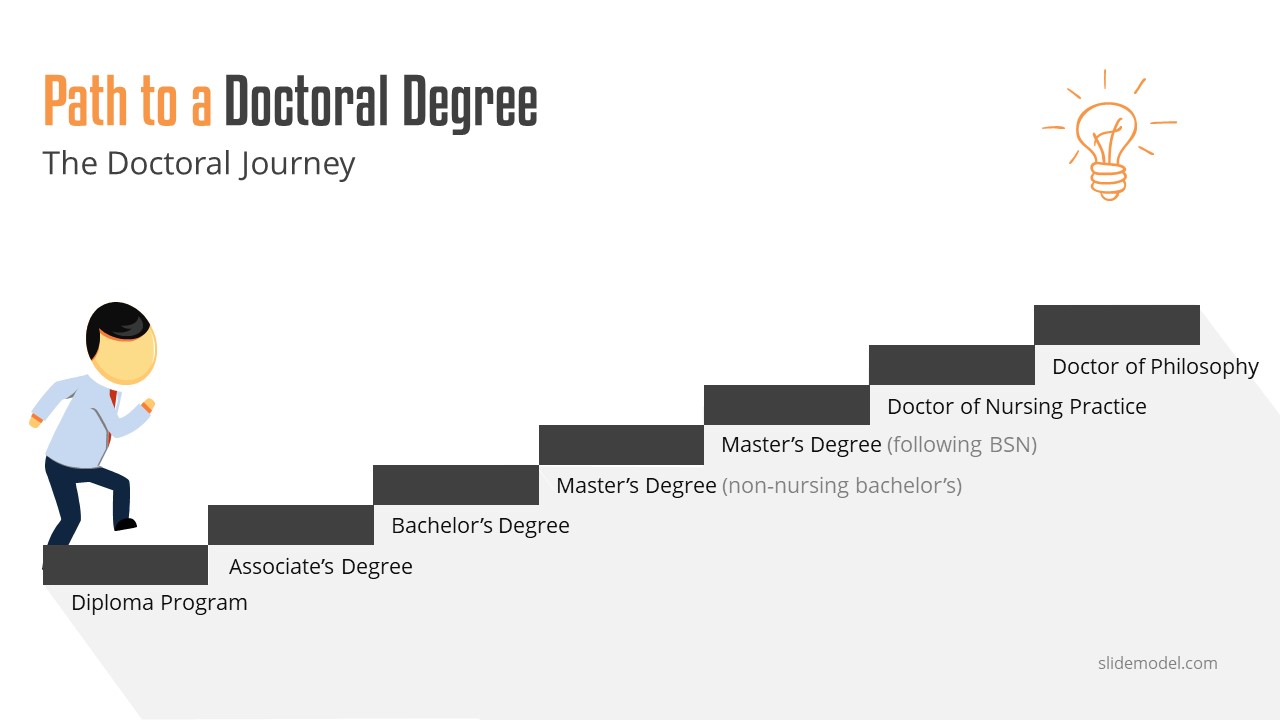
USA: In the United States of America, they consider a thesis shorter than a dissertation. In fact, aside from being a requirement to graduate in college, a thesis is now also inculcated in master’s degree programs. And since the dissertation is more extensive, the thesis is treated as preliminary in gaining a doctorate degree.
Europe: The distinction between the two papers is almost opposite to that of the USA. In Europe, a dissertation is only a broader research study from a post-graduate program and not the making of original research. Instead, educational systems in the said continent treat the doctoral thesis as a more elaborate paper writing.
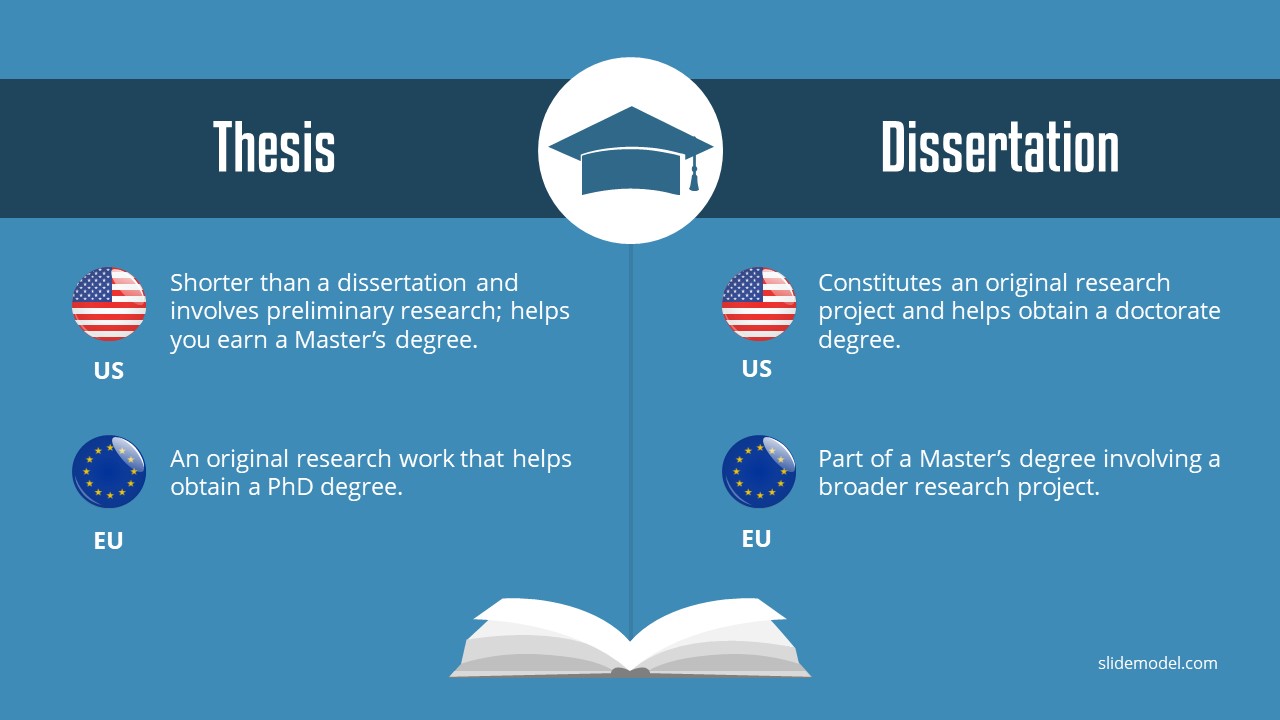
The difference between a thesis and a dissertation might not seem that big, but it’s important that we know what makes them different.
If your upcoming defense gives you pressure and uneasiness, it could be cause you are not sure what to expect. Today we will dispel three common thesis defense myths that will help you be more confident in your presentation.
“Answer all the questions correctly. Otherwise, your thesis won’t get approved.”
You are expected to have a focus on your research.
That being said, you have to study each part of your thesis, every detail, and even your sources.
You have to study and practice how to effectively deliver your presentation.
But don’t overthink to the extent that you’re stressing yourself to know everything perfectly.
Don’t overstress if you can’t answer one of the questions, this doesn’t necessarily mean the committee won’t approve your thesis.
You should know that research is a continuous study.
So you should expect that your committee will always be able to find a gap in your study to fill in future related research .
So in times you don’t exactly know the answer, admit it, and you’ll learn as they give their sides or suggestions.
Making up an answer will only displease your committee, so it’s to be upfront, honest, and transparent.
“The committee is just there to find holes in your study. They don’t care about you.”
One of the typical descriptions students have of the committee is that they are just there to poke holes in your thesis.
Going in with this perspective makes standing before them a nerve-wracking experience.
They’re not your enemy.
In fact, they are there to help you polish your study.
They might challenge you with difficult suggestions and tricky questions.
In the end, they will walk you through the process to come up with better results that won’t only benefit you but also your research.
They care about you and your study, and they’re ultimately there to make your thesis and the research better. Separate yourself from your work look at it objectively, and don’t take their comments personally .
“If your thesis defense isn’t successful, you have to start your thesis all over again”
An unsuccessful defense is one of the worst-case fears most students have.
One thing that you should be aware of is when you aren’t able to please your committee, you don’t need to start a new thesis again or go back to square one with your existing paper.
It’s unusual that your committee will ask you to change your topic and start from scratch again.
The fact that you’ve been permitted to defend your study means your research is almost complete.
They might suggest further details or ask you for minor revisions, and that’s normal.
But overall, you need to go into this defense thinking that your presentation will be successful. Otherwise, you are already setting yourself up for failure with the wrong mindset.
Remember that positive thoughts attract positive results.
Thesis Defense Presentation Structure and Slides Content
We can use language learning models like ChatGPT to help us curate the structure of our thesis presentation. Let’s see a step-by-step solution on how to apply this.
Step 1: Define the thesis topic and research questions
You can set the environment for ChatGPT to work by explaining what your thesis is going to cover and which specific questions you aim to address through the course of that document. This gives ChatGPT the context from which it shall formulate the structure. A prompt can be written like this:
“Take the role of an academic professional who shall help me to write my thesis. This thesis is going to cover the topic of (insert topic), and through its course, I want to answer these questions: Question 1 – Question 2 – Question 3 – Consider this information as the starting point for this chat.”
Step 2: Ask for an outline
With the previously provided information, ask ChatGPT to generate an outline for your presentation. If some of the points listed in the output don’t convince you, then chat with the interface until you reach a final outline. Then, ask to elaborate on each specific point for information or cues you may have overlooked.
Step 3: Ask ChatGPT which content should you place per slide
Instead of debating how are you going to trim your thesis into a presentation format, ask ChatGPT to do the decision process for you. You can be as specific as asking how many words per slide, how many slides should the presentation have, if you need any visual element, etc.
N.B.: We don’t recommend using ChatGPT to retrieve academic references as, in some cases, it can provide faulty results. You can ask if any facts on this presentation need to be checked or similar questions. ChatGPT is a powerful tool, but it shouldn’t be considered a bible, so be extra cautious about grabbing content directly from its outputs.
1. Title Page
This slide should contain the information that is provided on the title page of your hard copy . Here is an example of title page or cover slide for your title defense or thesis presentation.

- The title of your research paper
- Where you are studying
- Name and details of your course
- Name of Adviser
2. Introduction Slide
Your introduction slide should provide the committee with an idea of the following:
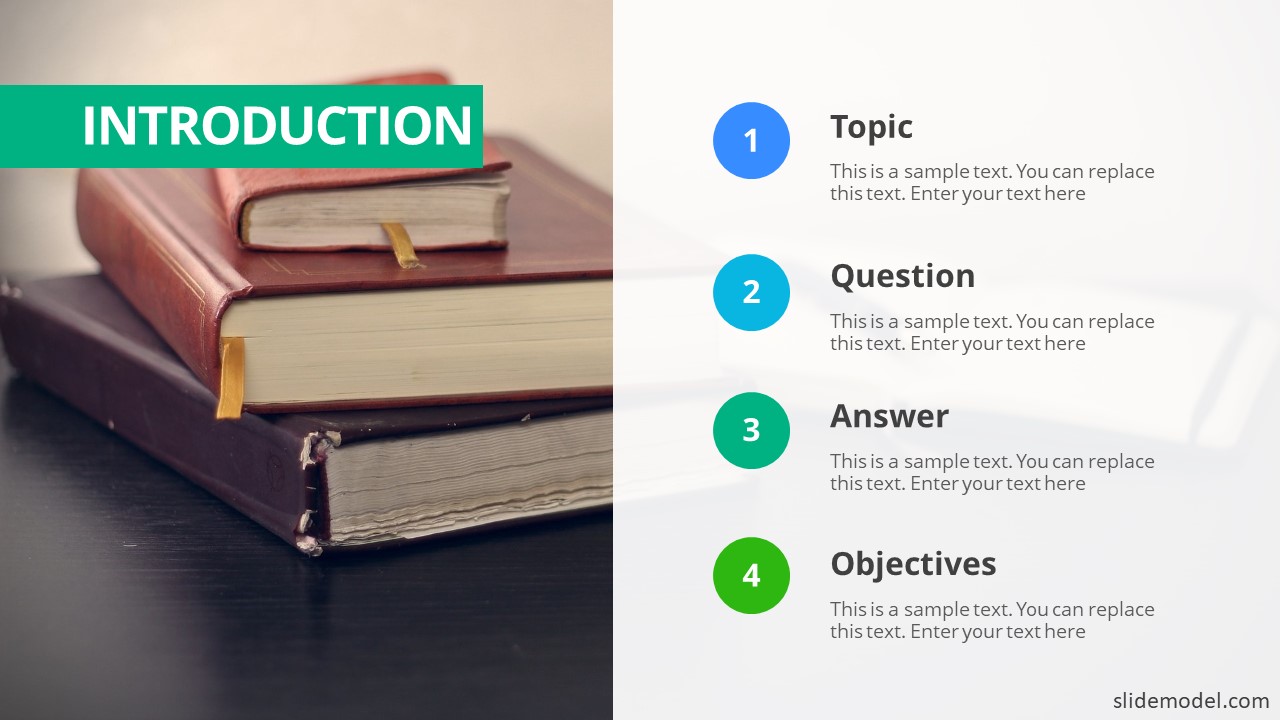
- What is the topic area that you are investigating ?
- What are the specific research questions that you set out to answer?
- Why is this question important to answer?
- What were the objectives of your research?
3. Literature Review Slide
It’s not necessary to cover everything that’s currently understood in the available literature. You may want to present the following content under a Literature Review slide:
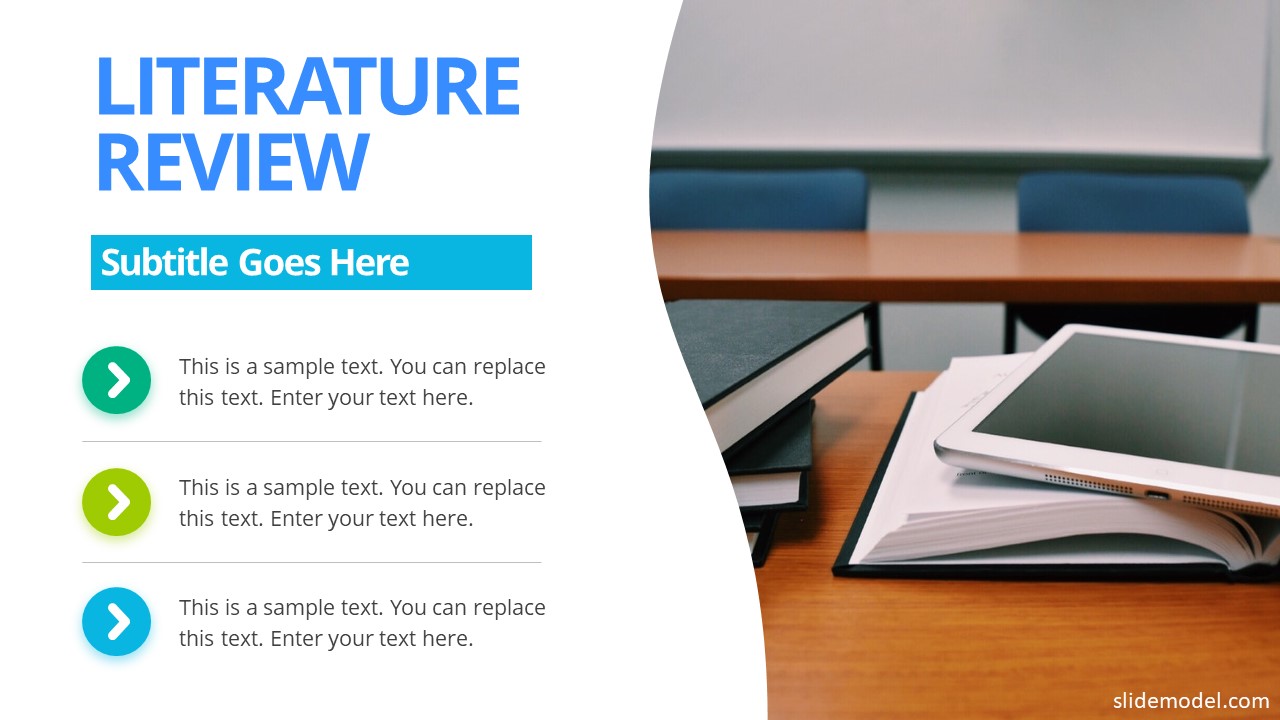
- Relevant current research that is close to your topic
- Different theories that may apply to your specific area of research
- Areas of weakness that are currently highlighted
4. Methodology Slide
Make sure to touch the factors below within your process, and include the following in the Methodology slide:

- The type of study you have conducted: qualitative, quantitative, or mixed
- The methods that you chose and why
- Details of the population, sampling methods, and other information
- Provide information regarding how you have analyzed the data that you have collected
5. Results Slide
This part should give the committee/audience a good understanding of what you’ve discovered during your research. The statistics & results slide could include the final results of your analysis, here is an example:

- An overall description of the data that you collected during your research
- The results of the analysis that you have done on that data
- What were the most significant findings from your data
6. Discussion Slide
Highlight here the meaning of the findings in relation to your discipline program and the research that you have done:
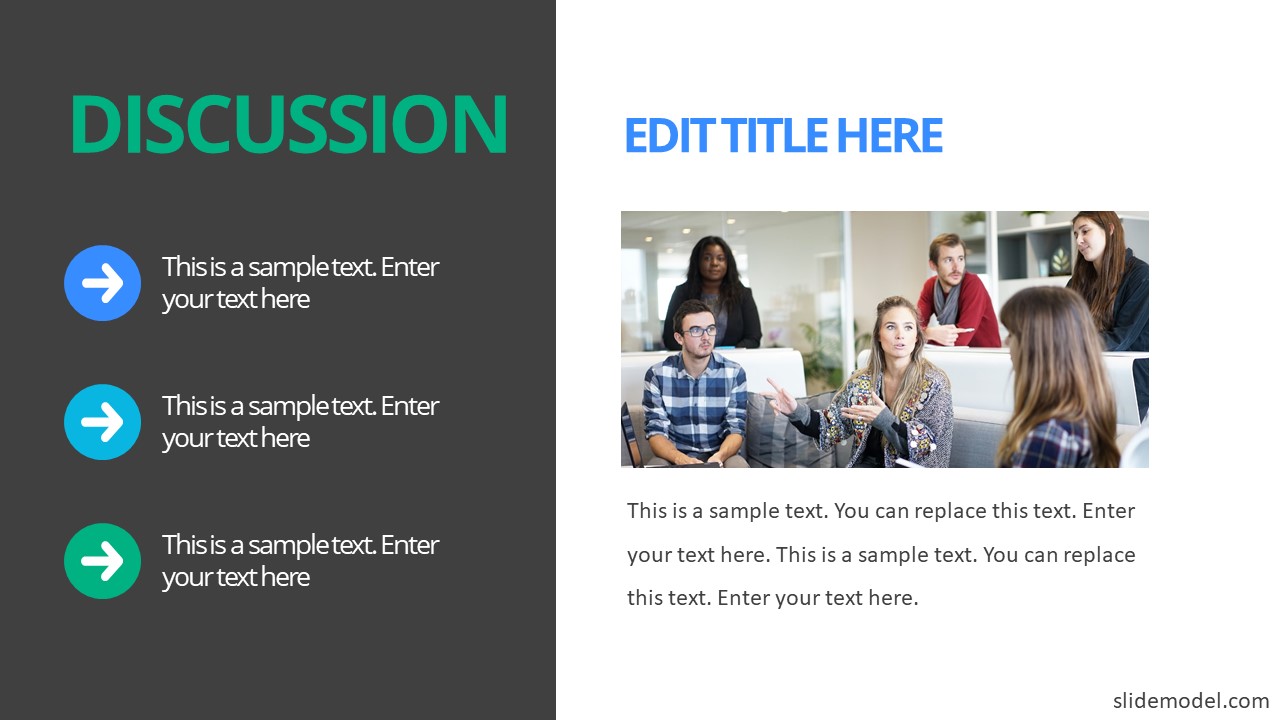
- What are the major findings, and what do they mean with regard to your research
- How do these findings relate to what others have found in the past
- How can you explain any unusual or surprising result
7. Conclusions Slide
You have to end your presentation with a conclusion summarizing all that you have found within your research. Here is an example of a Conclusion slide in a Thesis presentation:

- Restate your research questions
- Show how your results answer these questions
- Show what contribution you have made
- State any limitations to the work you have done
- Suggest future research
- Make any recommendations
See Also: How to Create a Great Investors Pitch Deck and Close the Deal
8. Acknowledgements Slide
Express gratitude to your advisor, committee members, peers, and others who supported your research journey. This slide provides a moment to acknowledge the collaborative nature of academic work.
9. Questions and Answers Slide
Dedicate a slide for audience questions at the end of your presentation.
Encourage engagement by inviting questions from the audience.
Be prepared to provide clear and concise responses to inquiries.
10. References Slide
Include a slide listing your cited sources throughout your presentation.
Use a consistent citation style (APA, MLA, Chicago, etc.).
The References slide demonstrates your thorough engagement with existing literature.
11. Contact Information Slide
If you’re open to further inquiries or collaborations, consider adding your contact information.
Include your email address or relevant professional social media handles.
How to use SlideModel AI Presentation Maker for your Thesis Presentation
If you want to save hours of manual time, you can leverage AI tools to make your thesis presentation. The best part of integrating AI tools into our workflow is that we can pair them to get even better results than we expected. With SlideModel’s AI presentation maker , users can create an entire slide deck by introducing these variables:
- Topic of your thesis
- Number of slides to include in your thesis presentation
- Outline checkup
And that’s it! Download the AI-generated presentation in PPTX format or for Google Slides, and edit it if you require adding some extra content. The core elements are already done, and you can save countless hours of hard work.
Tips During Your Oral Defense!
Review your materials.
Even if you already feel confident with your upcoming presentation, you still need to review your materials.
You can bring the hard copy of your thesis with you during the defense, but you don’t want to get lost in your presentation when you forget some specific details and have to scan your papers.
You should know your paper in and out.
Rehearse Your Presentation
It’s not wrong if it sounds like a script when you speak in your oral defense. It’s expected and understandable.
You need to practice your presentation, especially when there’s a time restriction given to every presenter.
You only need to prepare enough slides that would fit your time limit. A hundred slides aren’t suitable for a 15 to 20-minute presentation, nor 10 slides for an hour of defense.
Your rehearsal will be more effective if you practice it in front of an audience.
Note: You will experience complete silence in the defense room. You might feel awkward because, most of the time, you’re the only one speaking out loud. This is completely fine, and it’s something you should practice in rehearsal should you be afraid.
Narrow the Presentation of Ideas
Regarding your slides, you don’t have to include everything that’s in your paper. You should narrow down your ideas to the main points and the most important details, such as the statistics and findings.
If the members of your committee think you lack details or they want to hear a further explanation, they won’t hesitate to ask you.
Prepare for the Unexpected Questions
The panel tends to challenge the presenters, usually through some hard questions.
Its aim is how well do you you have done your research and how prepared you are.
But as long as you know the ins and outs of your paper, you shouldn’t lose your confidence regardless of which questions they ask.
Just keep in mind that what you’re saying in your oral defense is not in conflict with what is written on the hard copy you provided them.
What To Do When You Don’t Know the Answer
If the committee asks you a question and you don’t know the answer, don’t make up a baseless answer.
Baseless means out-of-context answers or something without proof or backup.
How To Deal With The Nervousness
The committee expects you to be nervous. Of course, it’s normal.
However, one effect of being nervous is the changes in your behavior.
There’s a tendency for you’ll talk fast, which will make it hard for the committee to understand you.
It might also cause you to have a mental block.
So try to slow down. Take a deep breath.
Inhale, exhale. Remember to breathe!
It’s OK to pause, and it’s OK to take your time; it’s more important that the committee clearly understands what you are trying to articulate.
More Quick Tips on How to Present!
- Introduce yourself at the beginning
- Introduce the title of the presentation
- Don’t read your notes if possible
- Don’t speak too fast
- Put an emphasis on what you’re saying so you don’t sound monotonous
- Look at your adviser once in a while for possible signs
- Stand on the right of the white screen if you are right-handed so you can easily refer to the slide without giving your back to the committee
- Face the audience when you talk
- Keep an eye contact
- Make sure to keep attention to the reactions of the committee and don’t forget to react in turn
We hope you enjoyed this article on how to do a proper thesis defense and how to best prepare for one using proven tips and techniques to help you get through this. Hopefully, after your defense, you will be set as the one in your class to deliver an inspiring graduation speech for your peers. If you have value, please remember to share this article. We also recommend you read these Thesis Statement Examples for inspiration to create your own professionally.
1. MasterDoc PowerPoint Template

Creating a Thesis presentation should be a straight forward task; based on your thesis document and following the tips described above you have a high level structure already outlined. The MasterDoc PowerPoint template provides professional layouts with texts and image placeholders; so you can create document like slides using your thesis defense as your content. This template is ideal for a highly detailed documents, where visuals and words unite to illustrate one concept per page. The result is an asset that can be read and digested more quickly than either your thesis document or a presentation created for assisting a speech. A document created with the MasterDoc PowerPoint templates is meant to be printed or distributed, read on screen without the accompaniment of a presenter or used in an e-learning platform as pure learning content.
Use This Template
2. Thesis Presentation PowerPoint Template
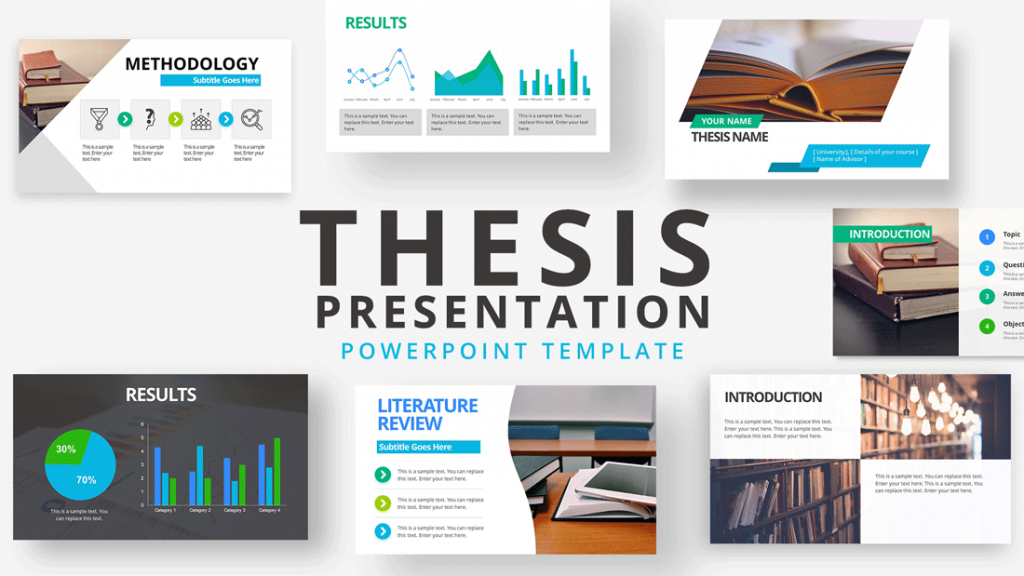
You had invested a considerable time researching, testing hypothesis and confirming your thesis. Craft your thesis presentation with the same level of detail you applied in your work. Using the Thesis Presentation PowerPoint Template you will focus only in your content and your message. The layouts, images,design and structure will be taken care by the template.
3. Master Thesis PowerPoint Template

The Master Thesis PowerPoint Template is a professional document designed for postgraduate degrees presentations. It provides simple sections that follow the structure and best practices of traditional research thesis presentations. Starting with the introduction to the theory and state of the art scenario; following with hypothesis research and its findings and concluding with the confirmation or negation of the initial thesis statement.
4. Essay Outline PowerPoint Template

Your thesis defense can be accompanied by an essay, that states your thesis and argues about it using several supporting paragraphs. This kind of document is ideal to be an intermediate step between reading assisting to the thesis presentation and reading the complete thesis documentation. It has more information that your thesis defense abstract, but does summarizes the supporting evidence and examples that allows the argument of each idea behind the thesis. You can use the Essay Outline Template to present your Essay outline and create an essay linked to your thesis defense documentation.
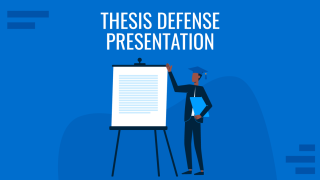
Like this article? Please share
Academics, Degree, Dissertation, Doctorate, Education, Faculty, Master, PhD, Student, Thesis Filed under Presentation Ideas
Related Articles

Filed under Presentation Ideas • November 9th, 2023
How to Create and Deliver a Research Presentation
Presentation is one of the final steps of a research endeavor. Learn how to make and deliver a research presentation using our templates and tips.

Filed under Education • September 10th, 2023
How To Write An Essay? – Where to start?
Do you wonder How to write an essay ? Start with the essay structure. This post describes the standard essay structure with its content, and which essay types are popular. Develop your writing skills using the best practices of Essay Structure.
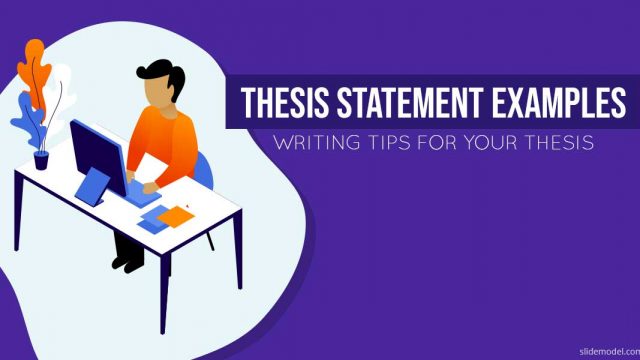
Filed under Education • September 2nd, 2023
Thesis Statement Examples
What makes a good thesis statement? Simple answer, precision and enough evidence to support your statement. In this article we analyze what are good thesis statements with examples.

36 Responses to “How To Do a Proper Thesis Defense Using the Right PowerPoint Presentation”
Great job! This has made my thesis presentation a whole lot easier.
Excellent !!!!!
Now I feel I’m quite confident on how to do my dissertation presentation properly and how to defend it. I will share that with other friends and colleagues.
Thank you so much for your kind help.
Best regards, Awad
Thank you for such a valuable guide.
it was very helpful
Thanks a bunch for the general summary for thesis defense with all related information that we might have to know. Great job!
Great tips.
i have proposal defense in two days and im so nervous right now! reading this is helpful in some ways thankyou!
It’s very helpful and understandable. Easy steps to follow.
I found it very helpful to refresh and make my self ready for my defense!
Thank you a lot this article. It’s really helpful!
Naveen Kumar S: Thank you its very Helpful. I appreciate all your effort this is very useful.
Very important and interesting so go on thank you
I really like it. In the near future I am going to present for the MA thesis. Therefore, it will guide me a lot. If you can please attach with this email the detail.
I do like the article as it proves to be valuable and worthy. I enjoyed reading every single note. It helped me feel at ease and have confidence when my viva day takes place. THANK YOU SO MUCH.
Appreciate your Assistance
Thanks a lot for the gist
Thank you so much, I got full information and knowledge.
This has made me look forward to my thesis defense. Thanks a lot
Very useful
thank you very much for your best information
Thank you very much the article is full of knowledge on Thesis as well as dissertation defense. Big Up!
I am appreciative. Well informative and educative.
Thanks immensely for these wonderful tips on presentation during defense. I personally found more useful to me as I prepare to defend my Master Dissertation.
Thank you very much! I now feel more confident.
Thanks for your good self overall usability of the Participations motivated points and contribute significantly in thesis defense practices. Best wishes to one and All
Happy To Help.
Thank you very much. As I am pursuing for my PhD in Leadership, I got it so meaningful and worth having.
Your tips on What a Thesis and Dissertation are, are on point. I have fully understood their differences and similarities. I have also noted the killer way of summaring a Power Point Presentation. Slidemodel.com…you are just a force to reckon with. I need more information…in case you have models you can share with me and those interested in this subject covered.
Thanks a million times for your timely guidance. Just preparing to do my PhD Thesis defense.
this was very, very helpful…Thank you!
Highly appreciate your effort to deliver what a student is looking for. I find your article really helpful and to the point. Thanks !
Regarding to my P.P, I’ve understood so many issues from this. Thankyou!
i got it as it is so important for my deffence presentation, thanky you very much
This Material was very hopeful and encourage any student who prepare any presentation relation with thesis. It also combined more encauragable and it enhance presentation!
Thought provoking content Thank you.
Great comments. very helpful
Leave a Reply
How to Create an Effective Dissertation Presentation
For many students, the task of writing a lengthy dissertation is so daunting that they forget about the need for Dissertation Presentation! Amidst all the hard work of researching and writing, students in some courses still need to prepare for a high-quality presentation that will help them earn top marks. This article will help you prepare and give you some essential tips for success.
The Purpose of Dissertation Presentation
There are two main types of Dissertation Presentation that are normally encountered in UK universities:
Mid-Research Presentations
Students will often be asked to present their dissertation work at a mid-point in their research. These presentations are usually made to a panel comprised of various faculty members from your department. In addition, they are sometimes structured as a postgraduate seminar, in which fellow students also attend. Both faculty and students can pose questions. The purpose of these Mid-Research Dissertation presentations is to provide students with an opportunity to demonstrate their progress and identify any weak areas that need to be addressed.
Assessment Presentations
Students are also sometimes required to make a Dissertation Presentation as part of their overall assessment . This is a much more formal presentation than the Mid-Research one, and it is usually open only to the student, examiners and the research supervisor. During an Assessment Dissertation Presentation, the student is required to present a summary of their research and results. They will then be asked questions by the examiners in a somewhat lengthy oral examination. The purpose of this Dissertation Presentation is to assess the student’s original research project and test its scholarly validity.
Differences in Undergraduate and Masters Presentations
Dissertation Presentations may be required at both Undergraduate (Bachelors) and Postgraduate (Masters) levels. The key difference between these levels is the length and degree of originality expected. Postgraduate Dissertation Presentations will normally be longer than Undergraduate Presentations, and they will demonstrate a greater degree of critical engagement with the subject matter. They will also demonstrate some degree of original thinking. By contrast, most Bachelors Dissertation Presentations will be shorter in length and will only require a thorough knowledge of the topic rather than an original scholarly contribution of any kind.
What to Include
- Broad subject area – What subject area of your discipline does your work fall into?
- Narrow topic area – Within this subject area, what is your specific topic? (This may be simply an expanded discussion of your research title).
- Relevant Existing Studies – What studies have already been done on your specific topic? What are their strengths and weaknesses? How does your work fit among them?
- Methodology and Philosophy – What methodology have you chosen to conduct your research? Is there a specific philosophical context? Why is this a good approach?
- Project Resources – If this is a Mid-Research Presentation, what resources do you require to complete the project? Furthermore, have you identified likely sources of funding, or do you need any difficult-to-acquire materials?
- Case Studies – If you’ve conducted practical fieldwork or lab research, why did you choose these cases or projects? How are they the best choices for researching your topic?
- Research Results – If this is a Dissertation Presentation for Assessment, note the results of your research in detail. Relate these back to your theoretical framework and discuss how the results support or contradict existing studies.
How to Prepare for your Dissertation Presentation
The best way to prepare for your Dissertation Presentation is to review your work carefully. Take notes of the key decisions you have made throughout your research and the scholarly literature that supports these choices. Make sure that you have a thorough understanding of the scholarly context of your research, which should have been achieved in your early research stages.
Once your content has been written, you should create a PowerPoint presentation to use during your talk. Don’t forget the slides should be informative but not wordy – keep bullet points concise and use pictures sparingly. Make sure that you rehearse your presentation several times.
What Sort of Questions to Prepare For Dissertation Presentation
The questions you will face in a Dissertation Presentation are designed to test your knowledge of the subject area and your awareness of the context of your work. You will be asked questions to determine how well you understand the potential criticisms of your project, and how well you are able to defend this. Therefore, remember to reference established scholars and existing research.
You might be asked about the specific choices you’re made with regard to methodology and case studies, and how you accounted for any possible inaccuracies in your resulting data. Similarly, examiners frequently ask students what they would do differently if they were starting the same project again.
You should also be prepared to answer questions about the ways your research might be applied within your field, and how it might be supplemented in future. This is an effective way for examiners to assess the originality of your research, and consider its potential impact on your subject area.
How to Earn a High Mark
Much of your dissertation mark will come from the written work and the research project it represents. However, a good Dissertation Presentation will help make a strong case for a good overall mark, whereas a weak Presentation will confirm any doubts in the examiners’ minds. As such, here are a few key areas for success:
- Good Presentation Skills. As with any Presentation, it is important to speak clearly and concisely. Stand still and look your audience in the eye, and try not to rely too much on notes. Be sure to keep breathing and don’t rush your words!
- Knowledge of the Topic. If you truly have a good understanding of your topic you will be likely to do very well. Remember, much of the Dissertation Presentation is designed simply to test your knowledge. If you’ve kept pace with your reading assignments and practical work you should have no problem answering any questions that are posed to you.
- Professional Behaviour. Stay calm and focused during your Presentation, and answer any questions with objectivity and professionalism. Don’t be drawn into debates, but instead offer references to other scholars whose work supports your own agenda.
- Take Your Time . Many students make the mistake of rushing through their material and answering questions too quickly. This doesn’t give the audience a chance to thoroughly understand the quality of your work. Furthermore, it risks leaving out essential information and neglecting to demonstrate the depth of your research.
Presenting your PhD in 20 minutes: how do you get started?

“One of the best presentations seen in Corona times.” This sentence comes from the jury report, following the PhD defense of Elien Bellon (KU Leuven). Her research focuses on metacognition in the development of primary school children’s mathematical cognition. She was asked to explain her PhD to a jury and a diverse audience in twenty minutes. How exactly do you go about this?
With sweat beading on her forehead, she decides to enlist the help of The Floor is Yours and sends us the following message:
“I already attended a workshop with you in the past and have read your terrific book. Soon I will be defending my PhD and the university has asked me to do this online. I generally enjoy giving presentations, but am feeling a bit apprehensive about giving an online talk. Normally I draw my energy from seeing a live audience in front of me. How should I approach giving an online presentation?”
We schedule a time to meet. Beforehand, Elien provides me with an audio pitch in which she briefly outlines her research.
I quickly notice that she has all the elements for a stellar talk: a passion for her research and a captivating story. All she needs to do now is clearly bring her story across, and she will be all set.
During the first session I share with her the following tips:
- Develop a new storyline. Compare a presentation to a travel blog. While you would love to share every detail chronologically, what the audience wants are the highlights. Push your thesis or recent publication aside for a moment and instead pull out a blank page to draw up a new storyline.
- Focus on a goal. What would you like to achieve with your presentation? The goal often seems to be to share as much as possible in the shortest possible time. But Elien’s goal is to give the jury a clear picture of her research and show them that her approach is valuable.
- Start with a simple version of your story. In your introduction, immediately tell the audience where you are headed and what exactly the challenge is. So, before diving into the depths with them, first explain your course of action.
- Make it concrete. Elien’s research focuses on math skills among primary school children, and more precisely metacognition. She provides a general definition of the term, but as long as her audience does not clearly understand this, it will not stick. Instead, first share with your audience an example or a concrete application, and then move on to a definition.
Elien begins to apply our tips. According to university guidelines, she must pre-record her presentation. She decides to make an animation video, with a personalized avatar explaining her research. For this, she uses the Powtoon software.
The day of the online defense, the jury and the audience will first view the video and that will be followed by a question round. We’re excited to hear the reactions!
What does the jury think?
The jury’s immediate reaction is one of praise: “You should certainly consider taking part in presentation competitions. You did very well, both in terms of content and design. Everything was very clear, even for non-experts.”
Also Elien’s colleagues and external attendees are very enthusiastic about the video. At last they now understand the full picture of her research. Elien’s social media accounts see a sudden uptick in new followers and she receives several emails with targeted questions about her research.
Elien: “I couldn’t believe the number of messages I received from people who had found me through Twitter. They asked where they could read more about my research. By creating an animated video I had attracted plenty of attention. I put a lot of time into it but would definitely do it again. Now if someone asks me about my research, I simply share with them the link to my video.”
What tip would you give to fellow researchers?
Elien: “Don’t be afraid to say: “This is how I see things.” Otherwise your message will be lost. I used to have trouble using language that, in my mind, was very black or white. I always wanted to communicate dozens of nuances. I now discovered that you can easily poor those nuances into your answers during the question round.”
How you can improve your online presentation
Will you soon be defending your doctoral or master’s thesis online? Do you need to present your research online? Or are you struggling with the lessons you now teach your students from home? We help you on your way to communicate your message clearly and convincingly online. How?
- Download our free guide ‘How to present online?’
- Watch the videos of our webinars.
- Book our workshop on how to present online.
- Presenting online
Don't miss any tips from The Floor is Yours.
Want to receive our latest blog posts and stay informed about our upcoming activities? Be sure to subscribe to our newsletter.
- Email address *
- Hidden Language
- Comments This field is for validation purposes and should be left unchanged.
Connect with us
- Copyright © The Floor is Yours
- Privacy policy
Privacy Overview

13 Tips to Prepare for Your PhD Dissertation Defense
How well do you know your project? Years of experiments, analysis of results, and tons of literature study, leads you to how well you know your research study. And, PhD dissertation defense is a finale to your PhD years. Often, researchers question how to excel at their thesis defense and spend countless hours on it. Days, weeks, months, and probably years of practice to complete your doctorate, needs to surpass the dissertation defense hurdle.
In this article, we will discuss details of how to excel at PhD dissertation defense and list down some interesting tips to prepare for your thesis defense.
Table of Contents
What Is Dissertation Defense?
Dissertation defense or Thesis defense is an opportunity to defend your research study amidst the academic professionals who will evaluate of your academic work. While a thesis defense can sometimes be like a cross-examination session, but in reality you need not fear the thesis defense process and be well prepared.
Source: https://www.youtube.com/c/JamesHaytonPhDacademy
What are the expectations of committee members.
Choosing the dissertation committee is one of the most important decision for a research student. However, putting your dissertation committee becomes easier once you understand the expectations of committee members.
The basic function of your dissertation committee is to guide you through the process of proposing, writing, and revising your dissertation. Moreover, the committee members serve as mentors, giving constructive feedback on your writing and research, also guiding your revision efforts.
The dissertation committee is usually formed once the academic coursework is completed. Furthermore, by the time you begin your dissertation research, you get acquainted to the faculty members who will serve on your dissertation committee. Ultimately, who serves on your dissertation committee depends upon you.
Some universities allow an outside expert (a former professor or academic mentor) to serve on your committee. It is advisable to choose a faculty member who knows you and your research work.
How to Choose a Dissertation Committee Member?
- Avoid popular and eminent faculty member
- Choose the one you know very well and can approach whenever you need them
- A faculty member whom you can learn from is apt.
- Members of the committee can be your future mentors, co-authors, and research collaborators. Choose them keeping your future in mind.
How to Prepare for Dissertation Defense?
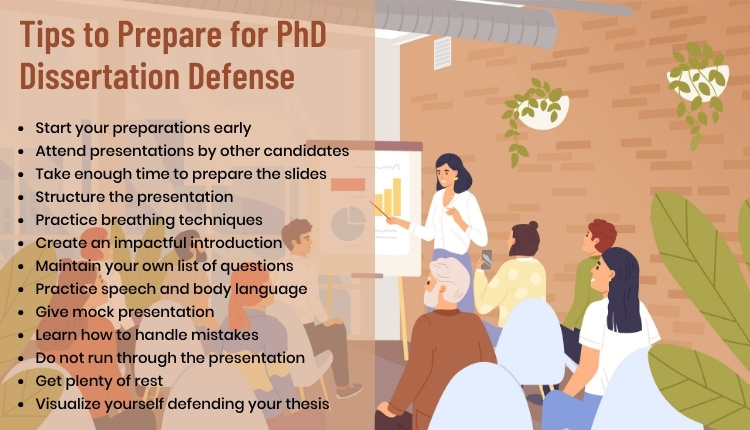
1. Start Your Preparations Early
Thesis defense is not a 3 or 6 months’ exercise. Don’t wait until you have completed all your research objectives. Start your preparation well in advance, and make sure you know all the intricacies of your thesis and reasons to all the research experiments you conducted.
2. Attend Presentations by Other Candidates
Look out for open dissertation presentations at your university. In fact, you can attend open dissertation presentations at other universities too. Firstly, this will help you realize how thesis defense is not a scary process. Secondly, you will get the tricks and hacks on how other researchers are defending their thesis. Finally, you will understand why dissertation defense is necessary for the university, as well as the scientific community.
3. Take Enough Time to Prepare the Slides
Dissertation defense process harder than submitting your thesis well before the deadline. Ideally, you could start preparing the slides after finalizing your thesis. Spend more time in preparing the slides. Make sure you got the right data on the slides and rephrase your inferences, to create a logical flow to your presentation.
4. Structure the Presentation
Do not be haphazard in designing your presentation. Take time to create a good structured presentation. Furthermore, create high-quality slides which impresses the committee members. Make slides that hold your audience’s attention. Keep the presentation thorough and accurate, and use smart art to create better slides.
5. Practice Breathing Techniques
Watch a few TED talk videos and you will notice that speakers and orators are very fluent at their speech. In fact, you will not notice them taking a breath or falling short of breath. The only reason behind such effortless oratory skill is practice — practice in breathing technique.
Moreover, every speaker knows how to control their breath. Long and steady breaths are crucial. Pay attention to your breathing and slow it down. All you need I some practice prior to this moment.
6. Create an Impactful Introduction
The audience expects a lot from you. So your opening statement should enthrall the audience. Furthermore, your thesis should create an impact on the members; they should be thrilled by your thesis and the way you expose it.
The introduction answers most important questions, and most important of all “Is this presentation worth the time?” Therefore, it is important to make a good first impression , because the first few minutes sets the tone for your entire presentation.
7. Maintain Your Own List of Questions
While preparing for the presentation, make a note of all the questions that you ask yourself. Try to approach all the questions from a reader’s point of view. You could pretend like you do not know the topic and think of questions that could help you know the topic much better.
The list of questions will prepare you for the questions the members may pose while trying to understand your research. Attending other candidates’ open discussion will also help you assume the dissertation defense questions.
8. Practice Speech and Body Language
After successfully preparing your slides and practicing, you could start focusing on how you look while presenting your thesis. This exercise is not for your appearance but to know your body language and relax if need be.
Pay attention to your body language. Stand with your back straight, but relax your shoulders. The correct posture will give you the feel of self-confidence. So, observe yourself in the mirror and pay attention to movements you make.
9. Give Mock Presentation
Giving a trial defense in advance is a good practice. The most important factor for the mock defense is its similarity to your real defense, so that you get the experience that prepares for the actual defense.
10. Learn How to Handle Mistakes
Everyone makes mistakes. However, it is important to carry on. Do not let the mistakes affect your thesis defense. Take a deep breath and move on to the next point.
11. Do Not Run Through the Presentation
If you are nervous, you would want to end the presentation as soon as possible. However, this situation will give rise to anxiety and you will speak too fast, skipping the essential details. Eventually, creating a fiasco of your dissertation defense .
12. Get Plenty of Rest
Out of the dissertation defense preparation points, this one is extremely important. Obviously, sleeping a day before your big event is hard, but you have to focus and go to bed early, with the clear intentions of getting the rest you deserve.
13. Visualize Yourself Defending Your Thesis
This simple exercise creates an immense impact on your self-confidence. All you have to do is visualize yourself giving a successful presentation each evening before going to sleep. Everyday till the day of your thesis defense, see yourself standing in front of the audience and going from one point to another.
This exercise takes a lot of commitment and persistence, but the results in the end are worth it. Visualization makes you see yourself doing the scary thing of defending your thesis.
If you have taken all these points into consideration, you are ready for your big day. You have worked relentlessly for your PhD degree , and you will definitely give your best in this final step.
Have you completed your thesis defense? How did you prepare for it and how was your experience throughout your dissertation defense ? Do write to us or comment below.
The tips are very useful.I will recomend it to our students.
Excellent. As a therapist trying to help a parent of a candidate, I am very impressed and thankful your concise, clear, action-oriented article. Thank you.
Thanks for your sharing. It is so good. I can learn a lot from your ideas. Hope that in my dissertation defense next time I can pass
The tips are effective. Will definitely apply them in my dissertation.
My dissertation defense is coming up in less than two weeks from now, I find this tips quite instructive, I’ll definitely apply them. Thank you so much.
Rate this article Cancel Reply
Your email address will not be published.

Enago Academy's Most Popular Articles

- Reporting Research
Choosing the Right Analytical Approach: Thematic analysis vs. content analysis for data interpretation
In research, choosing the right approach to understand data is crucial for deriving meaningful insights.…

Comparing Cross Sectional and Longitudinal Studies: 5 steps for choosing the right approach
The process of choosing the right research design can put ourselves at the crossroads of…

- Career Corner
Unlocking the Power of Networking in Academic Conferences
Embarking on your first academic conference experience? Fear not, we got you covered! Academic conferences…

Research Recommendations – Guiding policy-makers for evidence-based decision making
Research recommendations play a crucial role in guiding scholars and researchers toward fruitful avenues of…

- AI in Academia
Disclosing the Use of Generative AI: Best practices for authors in manuscript preparation
The rapid proliferation of generative and other AI-based tools in research writing has ignited an…
Setting Rationale in Research: Cracking the code for excelling at research
Mitigating Survivorship Bias in Scholarly Research: 10 tips to enhance data integrity
The Power of Proofreading: Taking your academic work to the next level
Facing Difficulty Writing an Academic Essay? — Here is your one-stop solution!

Sign-up to read more
Subscribe for free to get unrestricted access to all our resources on research writing and academic publishing including:
- 2000+ blog articles
- 50+ Webinars
- 10+ Expert podcasts
- 50+ Infographics
- 10+ Checklists
- Research Guides
We hate spam too. We promise to protect your privacy and never spam you.
I am looking for Editing/ Proofreading services for my manuscript Tentative date of next journal submission:

As a researcher, what do you consider most when choosing an image manipulation detector?
From admission to dissertation. Tips on making the PhD journey happy, productive and successful

18 tips to pass your Viva presentation
Viva Presentation of your PhD thesis requires you to prepare thoroughly. Viva Voce defense could be a failure if you don’t present properly. Learn tips on how to do PhD viva dissertation defense that makes you pass in doctoral viva. Face Viva exam confidently with an impressive opening speech. Keep some sample PhD viva questions and answers readily.
- Adjust voice as per the room size during the presentation of PhD viva.
- Clear Audibility is the first step for viva Voce success.
- Present Confidently viva thesis presentation.
- Do not stammer while defending PhD viva voce.
- Learn how to make an appropriate eye contact during PhD viva presentation.
- Keep ready some ready-made sample PhD viva answers.
- Know how to extend PhD viva validity.
- Never say you don’t know about any question
- Try to give your best from nothing during doctoral viva presentation.
Here are my detailed advanced tips on how to pass viva voce during your PhD studies. These viva tips will help you remain confident throughout your presentation
What is a Viva Voce?
A PhD scholar does not consider completing the thesis paper an accomplishment because they are still required to go through the viva voce process.
Although there are countries such as Australia that do not require one to do so, others like the United States necessitate the scholar to go through the process.
A viva voce is an oral examination whereby the researcher is required to stand before a panel of examiners to defend their dissertation .
This is why it is essential for the scholar to ensure that they have clearly mastered the field and the chosen topic by conducting the research on their own.
During the viva voce, the evaluators are at liberty to ask whatever question they feel is related to the topic and the candidate has the obligation of answering the question satisfactorily.
Simply put, a viva voce is an oral presentation that is aimed at proving that the researcher commands knowledge on the topic and has gained knowledge on the field of study.
When is PhD Viva voce examination conducted during PhD
A PhD viva voce examination is the last thing that comes in the PhD process whereby the researcher is required to present themselves before evaluators and answer any questions thrown at them regarding the thesis.
That said, the viva voce comes after the candidate has submitted their thesis to the faculty. Upon receiving the research paper, the evaluators may require the scholar to present themselves in person and required to exhibit what they have learned during the Ph.D. process.
Therefore, a viva voce comes after submission of the thesis and before the candidate earns the doctorate title.
How long is the PhD Viva Voce Presentation with example
Many Ph.D. candidates are concerned by the duration that a viva voce takes and we would like to point out that it all depends on how prepared one is for the same.
Traditionally, a viva voce is supposed to take ninety minutes with no hassles. However, it boils down to the examiners’ decision and if they feel that the time is not enough, then they can extend the process up to three hours.
The purpose of the process is to evaluate how much knowledge one has acquired during the Ph.D. and whether they are capable of answering questions related to their topic.
Therefore, it is true to state that the length of the viva voce will depend on the examiners. If the candidate does not satisfy their expectations, they are bound to ask more questions thus the process I likely to take more time
How many examiners will site in PhD Viva Examination
Many scholars are concerned about with the viva voce since it makes almost all candidates nervous as is the case of any situation where one has to stand before viva examiners and defend their work.
When one is deemed qualified to do a Ph.D., they are assigned a supervisor who ensures that the Ph.D. process is not marred by challenges through offering advice to the scholar.
The examiners are mostly two all of which should come from the university’s faculty. To ensure that the evaluation process is effective, they are mostly chosen from the same field as the candidate. Although it is not a must, there are occasions where the examining body may also comprise of external members.
This implies that the minimum number of examiners is two but they can be more according to the university’s decision.
Viva Preparation Questions
- What is the new thing that one feels to read your PhD dissertation?
- How do you prove this experiment can change the way others think?
- Explain the validity of your proposition with some examples.
- Give one strong why should we accept your thesis to be authoritative.
- What influenced you to make your thesis stand out from others
Why is PhD Viva Presentation conducted
A thesis is nothing short of a research paper which means that the scholar is expected to have taken their time to conduct thorough research using advanced techniques.
The main reason why a viva voce is conducted is to give the researcher an opportunity to defend their work before they are graded whether they meet qualifications or not.
The first thing that the scholar should know is that they should be able to defend their thesis which means that they should be aware of everything that is in the research paper. The reason for this is because one can never know what the examiners will ask and from which section of the thesis they will derive their questions.
It is essential that the scholar must ensure that they are prepared adequately by going through their thesis and ensure that they are able to answer any question arising from the same.
There are candidates who may be tempted to have other people write their thesis and although it may be perfect, the viva voce reveals the truth depending on whether they can defend the thesis or not.
Be what you are in your PhD Viva Exam
According to many candidates, the viva voce is an impeachment whereby they feel like they are grilled, but in a real sense, it is designed to prove to themselves and others whether they are in a situation to defend their title as a doctor of philosophy in their field.
It is therefore important for the candidate to ensure that they do not fall prey to brown nosing. They should not direct their efforts to sweet-talk the examiners by trying to impress them. Instead, the scholar is advised to play their role and prove to the evaluators that they are capable of defending what they have written in the thesis.
It is recommended that the scholar should be calm, relaxed and confident in their thesis and have the courage to stand before the examiners and express themselves.
The candidate should recognize the importance of the thesis and this is partly the reason why they have the responsibility of choosing their own topic and doing the research.
Never give one-word answers during Viva Voce viva exam
A viva voce must not be confused with a multiple choice questionnaire thus the researcher must appreciate that it is intended to diminish curiosity.
This cannot be achieved by giving one-word answers because the scholar is required to explain themselves as reflected in the thesis. Important to note is that a person’s standing or view on a certain view cannot be explained in a short statement.
The reason for this is because when one is asked a question during the viva voce, they are expected to state their position on the matter. The statement is not enough because it only triggers more questions.
Therefore, it is necessary that the scholar must support their claim by giving explanations as to why they support their arguments. In fact, the primary purpose of the viva voce is to ensure that the scholar can defend what they advocate for thus they should be in a position to give explanations and proof of what they are saying.
Be confident throughout the session (not over confident) during doctoral viva
According to human nature, there are people that find it easy to stand before others and air their view but the viva voce does not recognize that. It is essential that the scholar must be in a position to present themselves and stand for what they have presented to the faculty and the world.
At this level of learning, it is expected that the scholar must be confident enough to ensure that they can speak in front of a crowd leave alone two or three examiners. Confidence is a virtue that must be acquired by all scholars to ensure that they can stand before others and teach them or address key concerns that affect society.
However, the candidate must take caution not to be overconfident and the main reason for this is that too much confidence is interpreted as arrogance.
The bad thing about this is that the examiners are likely to get the wrong impression about the scholar. This is true because among the virtues that a Ph.D. teaches the candidate is patience and respect for others.
Do not show that you are afraid of Viva Voce of dissertation
The human mind is designed in such a manner that it controls the entire body and command activities that the individual will like and those that they will not.
One of the reasons why most scholars fail the viva voce process is that they tend to develop a negative attitude towards the same even before they go through the process.
It is essential that the scholar must be confident and not only outwardly but also inwardly. We recommend the scholar to ensure that they take all necessary measures to ensure that they do not exhibit fear in front of the examiners.
It is understandable that anyone is capable of nervousness while in front of a panel of examiners. However, we recommend that the scholar must pay attention to two things to boost their confidence. The first element is that they should prepare adequately for the process.
The second is that they should develop a positive attitude towards the viva voce. Adhering to these two advises is bound to increase the scholar’s confidence in themselves and their thesis.
My top Viva advice is to practice before one month
In the scholar’s life, before they take the Ph.D. course, it is true to say that they have gone through many examinations and passed. It is not automatic to pass an examination and it requires a lot of dedication and sacrifice.
Although there are individuals that may be tempted to take a shortcut, there is only one recipe to passing. All examinations require a lot of preparation and a viva voce is not exceptional.
This implies that the scholar must take their time to prepare for the viva voce beforehand. It is recommended that the candidate should take at least one month to prepare themselves.
It may seem like a difficult thing to do but we remind the scholar that they have a supervisor who has knowledge about the viva voce and they can offer useful advice that can make the process easy for the candidate.
Dress proper and be neat and formal during thesis viva preparation
The short description of a viva voce is that it is an oral presentation and therefore it means that there must be physical appearance.
Appearance has a powerful effect in that it creates a lasting impression on the examiners and therefore, the way that one presents themselves before the evaluators automatically make them judge the candidate’s character. The scholar wants the evaluators to be on their side and therefore the first thing that should pop in the scholar’s mind is creating a good impression.
It is essential because it may affect the examiners’ judgment which implies that a good impression is likely to yield good results while a bad impression is likely to yield bad results.
It is crucial that the scholar must dress formally for the viva voce and they should be neat. The proper dressing makes the scholar look responsible and in a position to defend their thesis.
Read your thesis once and thrice and prepare sample PhD viva answers
The viva voce is an oral presentation of the thesis and therefore it is necessary that the scholar must ensure that they have a proper understanding of their thesis before they engage with the examiners.
It is purposeful for the scholar to have 100% knowledge of the thesis even though it is common to forget some points. To avoid mistakes arising from being unable to answer some examiners’ questions, we recommend the scholar to make a point of revising the thesis before and after submitting to the faculty.
Some scholars might consider reading the thesis twice sufficient but this is not the case.
Others may be overconfident and feel that they do not have to read the thesis again but this is usually a recipe to disaster. It is our recommendation that the scholar reads through the thesis at least three times to ensure that they are familiar with all the points discussed within.
Learn how to start your opening speech of PhD Viva
It may sound tricky to summarize a paper comprising of at least 50,000 words in as little as five minutes but it is possible and the scholar should practice doing so.
Essentially, the examiners expect the scholar to have mastered their thesis and therefore they should be able to point out the problem surrounding the topic as well as the causes and recommended solution briefly.
At the onset of the viva voce, the scholar must be in a position to introduce the dissertation to the examiners briefly. This involves presenting an overview of the research paper.
Among the different sections of the thesis is the abstract section which was explained as a summary of the research paper. While preparing for the viva voce, the candidate is advised to consider the abstract and use it as a guideline for the oral presentation.
Listen to what your examiner is asking clearly
The easiest way to fail in any examination is answering the wrong questions or failing to address what the examiner requires.
It is mandatory for the candidate to pay attention to what the examiner is asking and carefully analyze points that they require from the candidate.
By doing so, the scholar is in a position to give the right feedback with reference to the thesis. It means that it is important for the candidate to concentrate during the viva voce and they should ensure that they are not distracted by anything else. 100% concentration is a requirement for the viva voce process if the candidate is going to answer questions satisfactorily.
Do not argue under any circumstance (just defend)
It should be noted that a viva voce is not a form of a debate where two parties are engaged in arguing. The candidate should note that the examiners are already professors and they are not there to engage in a battle of wits.
What they require from the candidate is proof that they have learned during the research and that they are in a position to demonstrate that they command knowledge in their specific fields.
That said, rather than argue, the candidate must ensure that the presentation is based on defending the thesis and shows the validity of the scholar’s standing regarding the points presented in the dissertation.
Pass- short corrections-resubmit- Fail after Ph.D. Viva defense
After the oral presentation, the examiners make a point of presenting their results to the candidate which point out areas that were sufficiently answered and those that were not.
The candidate should look into areas where they gave wrong answers and make a point of researching and making the necessary changes.
The correct answers should be passed to the examiners. The candidate must ensure that the correct answers are written as briefly as possible.
Do not write stuff on your hands or hold slip while defending viva thesis
During the oral presentation, it is necessary that the scholar avoids writing points in their hands or slip. It is so because it acts as a way of showing that the scholar has not prepared sufficiently for the viva voce.
In addition, it creates the impression that the researcher is not fully aware of the content in the thesis. Using written points give the impression of someone who is presenting a speech that has been written for them.
The candidate does not want the examiners feeling that they have not done the research for themselves as this would automatically lead to a fail.
How to do viva presentation with an impressive eye contact
A good presentation is one that the candidate commands presence before the examiners as it shows that they are confident with their work. It also shows that the scholar has worked hard for the thesis and they have nothing to fear regarding the viva voce.
One way of showing the examiners that the candidate is prepared and has dedicated themselves to the research is by making constant eye contact with the examiners.
The researcher should also be careful not to give too much attention to one examiner and instead they should keep eye contact with all the researchers during the whole viva voce.
Plan some expected questions and your answers
Whichever situation that one finds that they are required to make a presentation before a panel or a group of people, the first thing that the person does is to prepare adequately.
It is useful for the candidate to expect some questions that are likely to be asked during the presentation and therefore the scholar should make a list of some of them and work on possible answers.
Although one cannot fully predict the type of questions, it is important for the candidate to conduct a research of previous viva voce that have been done on the same field. Also, the scholar must consult the supervisor who may have useful advice.
Be ready to explain the drawbacks of your thesis cleverly
There is no perfect research and all of them are liable to limitations which the candidate must make a point of acknowledging before they are asked.
The scholar must be prepared to mention the drawbacks and explain why they arise. Merely stating the drawbacks is not enough since it will only make the examiners curios and therefore the candidate must defend the thesis wit-fully taking care to show that the limitations could not be avoided.
Challenges encountered during the thesis should be noted since they might be helpful in explaining the limitations or drawbacks.
Make rehearsals before two days of your viva voce
It has been noted that the scholar must ensure that they are fully prepared for the viva voce before meeting the examiners. Apart from reading through the thesis at least three times, the candidate should ensure that they prepare for the presentation prior to the scheduled day of the meeting.
If possible, the candidate is advised to look for friends and prepare a mock viva voce whereby they act as the examiners and ask questions that the candidate feel could potentially be asked.
This process should be done at least two days before the presentation. A rehearsal is important because it assists the candidate to engage how much they know pertaining to their thesis and some areas that may not have been given adequate attention can be addressed.
Never say “I don’t know” Somehow defend PhD viva (Be it wrong its ok)
A research paper consists of a lot of content and it may not be possible to remember everything that is contained in the same. It is common for the examiners to ask questions that the candidate has not prepared themselves to answer but this should not deter them from answering.
In case the candidate encounters such questions, they should not hastily state that they do not have the answer. Instead, the candidate should take their time and reflect on the thesis and analyze the connection between the question and the thesis.
It is understandable if the answer is not correct but at least the candidate should try to answer the question.
Prepare some positive statements of English to use them during presentation of your viva
One way of preparing for the viva voce is to ensure that one has answers to the examiner’s questions. The main areas of concern are the main points and how they are relevant to the topic.
A presentation must have statements that can be defended at all times since they help the scholar to show the importance of the thesis to the community. Such statements must be positive in nature and exhibit backing up of the thesis.
They should be prepared in English since it is the universal language that is applicable to almost all job specifications in the job market.
How to present PhD viva presentation positively
Positive statements are one way of the researcher showing that they have confidence in themselves and the thesis. Throughout the viva voce, the candidate must ensure that they have a positive attitude which is essential because it draws the examiners on their side.
A positive attitude makes it possible to answer questions easily and there is a likelihood that the examiners may not ask questions that put the candidate in bad situations. It enables the scholar to be motivated and therefore they are able to answer questions freely without feeling tense.
Be audible and do not look shy during thesis viva presentation
It is understandable that some people may have difficulty in standing before people and speaking their minds. However, the scholar is advised to remember that this is their dissertation and the presentation is among the stakeholders that determine whether one will pass or fail.
To counter shyness, the candidate is advised to prepare themselves adequately before the viva voce process. It is important because it boosts the candidate’s moral and level of motivation.
A scholar that is prepared becomes confident in themselves and they also develop a positive attitude which makes it easier to face the examiners and answer any question hurled at them without fear.
If you have had any experience with public speaking skills, you can do this task very easily. But unfortunately, you might have been lazy not to learn these skills when your English Teacher taught you during your school days. You need to give your count now while doing your Ph.D. viva. These skills are very necessary to get through these oral sessions. The way you speak is what matters seriously for the examiners or the reviewers.
Once you are through enough to make it, you can become successful. This way you can become a lot more confident and you will pass this viva without any doubt. While presenting do remember that you have to make some preparation for the last two months. This preparation is the only backbone for your viva. If you do not prepare beforehand you will face trouble while presenting your Ph.D. viva oral
When you keep this in mind, there are some other tips, I want to give here. See how PhD candidates do their viva online. If you go on to youtube you will get many videos in real time. Learn from them how they are able to present during such stressful sessions. I suggest you watch at least one video about Ph.D. viva or any other sessions with respect to Viva. This will surely give you fuller knowledge and viva presentations presentation tips about viva
When you want to give Ph.D. viva, try to show respect who are around you. They may be irritating sometimes to face. But you must never lose temper if someone asks you an inappropriate question. These type of unrelated questions are very common while giving your Ph.D. viva oral examination.
Master all the techniques on how to face audience and PhD supervisor during your viva voce. The way you speak, the way you behave, the way you respond, the way you manage, the way you present. All such skills must be learned before going to viva session.
You cannot make yourself a bluff in front of others for simple questions. So in order to avoid this, you must take your viva seriously and make sufficient preparation.
Never lose heart rather increase your active participation in the viva. If someone corrects you, accept it humbly and proceed to the next defending minutes. So Ph.D. viva is not a big problem if you follow all these suggestions throughout the reading on how to do Ph.D. Viva Voce.phd viva tips
Syam Prasad Reddy T
Hello, My name is Syam, Asst. Professor of English and Mentor for Ph.D. students worldwide. I have worked years to give you these amazing tips to complete your Ph.D. successfully. Having put a lot of efforts means to make your Ph.D. journey easier. Thank you for visiting my Ph.D. blog.

You May Also Like

Google Jam topics

Top 100 Jam topics in an Interview Session

How to Introduce Myself in Jam Session
- SUGGESTED TOPICS
- The Magazine
- Newsletters
- Managing Yourself
- Managing Teams
- Work-life Balance
- The Big Idea
- Data & Visuals
- Reading Lists
- Case Selections
- HBR Learning
- Topic Feeds
- Account Settings
- Email Preferences
Create an Effective Slide Deck
A great presentation depends on more than the high-quality information you’re sharing. Here are some essential principles to help you create a memorable slide deck. Choose the right fonts. Use sans serif fonts like Helvetica or Arial for a minimal look and better readability. Stick to two font styles throughout your presentation—one for headings and another […]
A great presentation depends on more than the high-quality information you’re sharing. Here are some essential principles to help you create a memorable slide deck.
Source: This tip is adapted from “How to Make a ‘Good’ Presentation ‘Great’” by Guy Kawasaki
Partner Center

IMAGES
VIDEO
COMMENTS
What would be a suitable - neither too short or seemingly-snappy nor too long and boring - way to address the audience at the very beginning of my talk? For instance, starting with . Hello everyone . sounds a bit too informal to me. Personally, I am inclined to starting with . Respected members of the examination committee...
A very traditional viva presentation structure simply follows the structure of the PhD thesis. This means that the viva presentation covers all parts of the thesis, including an introduction, the literature review, the methodology, results, conclusions, etcetera. Example of a traditional viva presentation structure.
My Best Tips for Scientific Presentation #PowerPoint #PhD #SciComm #TEDTalk #Communication (Long Title)Do you feel overwhelmed by the idea of presenting your...
Purpose of the Guide. This Guide was created to help Ph.D. students in engineering fields to design dissertation defense presentations. The Guide provides 1) tips on how to effectively communicate research, and 2) full presentation examples from Ph.D. graduates. The tips on designing effective slides are not restricted to dissertation defense ...
2. Know Your Audience. Most people give their thesis defense presentation to an academic panel. This panel will look to see if you've developed a thorough understanding of your topic and thesis. They'll also be looking to see if you've got a solid foundation for your argument.
Get prepared. The trick to giving a great presentation is to be prepared, know your stuff, and practice your talk until it feels completely natural to stand up in front of an audience. Perhaps your first presentation will be in an informal setting with other members of your lab during a weekly or monthly group meeting.
Use an appropriate language register (avoid informal language), but be approachable and natural. "Welcome to the thesis defense on [the title of your thesis]". Next, introduce yourself with your name and give a short description of your background and occupation. Don't forget to say "thank you for attending!".
Presentations with strong narrative arcs are clear, captivating, and compelling. Orient the audience and draw them in by demonstrating the relevance and importance of your research story with strong global motive. Provide them with the necessary vocabulary and background knowledge to understand the plot of your story.
You know what you're going to say, make sure you also practice how you're going to say it. Make a conscious effort to speak a little (emphasis on the little!) slower than you normally would. Don't forget to breathe and be happy - this is a chance to show off the great work that you've been doing. Speak clearly and not too quietly and ...
Define your presentation's theme. 4. Design simple and focused slides. 5. Include data visualizations. 6. Practice makes perfect. Things to keep in mind to help you nail your presentation. You've reached the home stretch in your journey toward your post-graduate degree.
Keeping your defense simple will cut through all the other noise. Work on narrowing the focus of each slide to cover one point. Just one. Condensing ideas is tough, especially when you're discussing a complex issue. But taking your presentation one slide at a time ensures the audience can follow your argument clearly.
Are you a graduate student preparing for your thesis defense? Your thesis defense is a crucial moment in your academic career, and it's essential to be well-...
2. Practice, practice, practice. It doesn't matter how confident or comfortable you are with regard to your work and the actual PhD dissertation defense — you need to practice like your life depends on it. Be sure to practice not only the presentation, but also your body language, like hand gestures. You don't want to seem too stiff or ...
PhD Dissertation Defense Slides Design: Example slides. Start; Tips for designing the slides; Presentation checklist; Example slides; Additional Resources; Acknowledgments. Thank all Ph.D.s for sharing their presentations. If you are interested in sharing your slides, please contact Julie Chen ([email protected]).
A streamlined presentation that's as professional as it is impressive. All with just a few clicks of the mouse. Our PhD defense template can also help you: Customize your PhD presentation for different audiences. Synthesize months of academic work into a concise presentation. Successfully defend your PhD thesis to your panel.
Learn how to prepare an oral presentation of your research! For more tips and advice visit urca.msu.edu
Consider this information as the starting point for this chat.". Step 2: Ask for an outline. With the previously provided information, ask ChatGPT to generate an outline for your presentation. If some of the points listed in the output don't convince you, then chat with the interface until you reach a final outline.
The best way to prepare for your Dissertation Presentation is to review your work carefully. Take notes of the key decisions you have made throughout your research and the scholarly literature that supports these choices. Make sure that you have a thorough understanding of the scholarly context of your research, which should have been achieved ...
Start with a simple version of your story. In your introduction, immediately tell the audience where you are headed and what exactly the challenge is. So, before diving into the depths with them, first explain your course of action. Make it concrete. Elien's research focuses on math skills among primary school children, and more precisely ...
Tip #1: Use PowerPoint Judiciously. Images are powerful. Research shows that images help with memory and learning. Use this to your advantage by finding and using images that help you make your point. One trick I have learned is that you can use images that have blank space in them and you can put words in those images.
Ideally, you could start preparing the slides after finalizing your thesis. Spend more time in preparing the slides. Make sure you got the right data on the slides and rephrase your inferences, to create a logical flow to your presentation. 4. Structure the Presentation. Do not be haphazard in designing your presentation.
Why is PhD Viva Presentation conducted. ... Learn how to start your opening speech of PhD Viva. It may sound tricky to summarize a paper comprising of at least 50,000 words in as little as five minutes but it is possible and the scholar should practice doing so. Essentially, the examiners expect the scholar to have mastered their thesis and ...
A dissertation presentation is usually a 10-15 minute overview of your dissertation research that focuses on the study and findings recorded in chapters four and five of your dissertation. The dissertation presentation consists of 9-12 slides made using PowerPoint or another type of presentation software. There are conventions to adhere to when ...
Here are some essential principles to help you create a memorable slide deck. Choose the right fonts. Use sans serif fonts like Helvetica or Arial for a minimal look and better readability. Stick ...